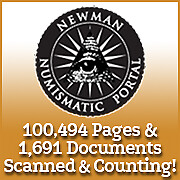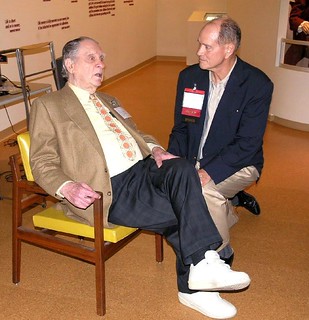
About UsThe Numismatic Bibliomania Society is a non-profit organization devoted to the study and enjoyment of numismatic literature. For more information please see our web site at coinbooks.org SubscriptionsThose wishing to become new E-Sylum subscribers (or wishing to Unsubscribe) can go to the following web page link MembershipThere is a membership application available on the web site Membership Application To join, print the application and return it with your check to the address printed on the application. Membership is only $20 to addresses in the U.S., $25 for First Class mail, and $30 elsewhere. For those without web access, write to: Terry White, Treasurer
AsylumFor Asylum mailing address changes and other membership questions, contact Terry at this email address: terrywhite5475@yahoo.com SubmissionsTo submit items for publication in The E-Sylum, just Reply to this message, or write to the Editor at this address: whomren@gmail.com Sale Calendar |
- WAYNE'S WORDS: THE E-SYLUM JANUARY 10, 2016
- KOLBE & FANNING’S NEW YORK BOOK AUCTION RESULTS
- LAKE BOOKS 124TH MAIL-BID SALE CATALOG AVAILABLE
- NEWMAN PORTAL DIGITIZES EARLY DEALER PERIODICALS
- NEW BOOK: COUNTERFEITING AND TECHNOLOGY
- NEW BOOK: ROMANIAN COINS (1989 TO 2014)
- BOOK REVIEW: WHO'S WHO AMONG AMERICAN MEDALLISTS
- BOOK REVIEW: A STUDY IN BANKING (IN SHERLOCK HOLMES)
- PCGS COINFACTS TO BECOME A FREE SERVICE
- DAN HOLMES 1938-2016
- ANA CELEBRATES ITS 125TH ANNIVERSARY
- NOTES FROM E-SYLUM READERS: JANUARY 10, 2016
- MICKLEY'S DATES OF US COINS AND THEIR DEGREES OF RARITY
- MORE THOUGHTS ON RARITY RATINGS
- LORENZO HARRIS ABBEY (1822-1881)
- MORE ON MAURITIUS DAVID
- HOW TO DO NUMISMATIC RESEARCH
- LITTLETON'S MAYNARD SUNDMAN JOINS APS HALL OF FAME
- SCOTT DOLSON POLITICAL MEDALS AND TOKENS STOLEN
- OLYMPIC MEDALS IN RR AUCTION SALE
- ROBERT EIDLITZ AND HIS BOOK ON ARCHITECT MEDALS
- ON BOOKSHELF MAINTENANCE
- HOW SLAVES EARNED SMALL AMOUNTS OF CASH
- WAYNE'S NUMISMATIC DIARY: JANUARY 10, 2016
- A COURSE IN MAMLŪK NUMISMATICS
- KING HEZEKIAH'S SEAL
- MAN HOLDS RECORD FOR NUMBER OF ACTIVE CREDIT CARDS
- OLD-DESIGN PAKISTAN BANKNOTES TO BE DEMONETIZED
- INDIAN OFFICIALS SUSPENDED OVER DEFECTIVE BANKNOTES
- DOG CHEWS CHINESE CASH STASH
- FEATURED WEB PAGE: JOSEPH MICKLEY'S DIARY
Click here to access the complete archive
To comment or submit articles, reply to whomren@gmail.com
WAYNE'S WORDS: THE E-SYLUM JANUARY 10, 2016

New subscribers this week include: Katherine Smoak, David McMahon, Dan Huntsinger, Lee Gast, David Bruce, David Schwager, Dave Reno, and Marc Schoneman. We now have 1,923 subscribers.
This week we open with results of this weekend's Kolbe-Fanning New York book auction, updates from Fred Lake and the Newman Numismatic portal, two new books and two reviews.
Other topics include PCGS CoinFacts, Joseph Mickley, rarity ratings, the Abbey Cent, doing numismatic research, Olympic medals, Robert Eidlitz, Dan Holmes, credit card collecting, and how slaves could earn money.
To learn more about Fulvio’s Illustrium images, the Coin Collector’s Journal, escapades of the Secret Service, Sheldon’s color set, modern Romanian coins, chronograms, and bookshelf maintenance, read on. Have a great week, everyone!
Wayne Homren
Editor, The E-Sylum
KOLBE & FANNING’S NEW YORK BOOK AUCTION RESULTS
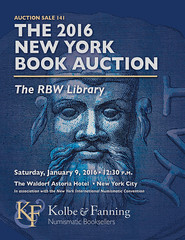 Kolbe & Fanning held our 2016 New York Book Auction on Saturday, January 9, at the Waldorf Astoria Hotel in New York. Conducted in
conjunction with the 2016 New York International Numismatic Convention, the sale featured the celebrated RBW Library on Roman Republican coinage and
other properties. The 455-lot sale brought above its total estimate and was a success on all fronts.
Kolbe & Fanning held our 2016 New York Book Auction on Saturday, January 9, at the Waldorf Astoria Hotel in New York. Conducted in
conjunction with the 2016 New York International Numismatic Convention, the sale featured the celebrated RBW Library on Roman Republican coinage and
other properties. The 455-lot sale brought above its total estimate and was a success on all fronts.
Some highlights included (all prices given below are hammer prices):
Lot 29, Bahrfeldt’s three-part revision of Babelon on Roman Republican coins, was keenly competed for and brought $4250 on a $1000 estimate.
Lot 42, the very rare catalogue of the Carlos de Beistegui collection, brought $6000.
Lot 48, a copy of Borghesi’s work on Cardinal de Zelada’s aes grave, with wonderful additional illustrations in ink, brought $2250 on a $500 estimate.
Lot 55, the Duke of Devonshire’s exceptional copy of the 1532 Paris folio edition of Budé’s De asse et partibus eius, will be returning to England, selling to a British buyer at $9000.
Lot 110, the 1517 first edition of Fulvio’s Illustrium images, the first illustrated numismatic book, brought $8000 on a $5000 estimate.
Lot 114, a heavily annotated set of Gessner’s rare plates on the Familiarum Romanarum, sold for $1800 on a $500 estimate.
Lot 193, a lovely set of the French first edition of Mommsen’s classic Histoire de la monnaie romaine, brought $3000 on a $750 estimate.
Lot 195, Morell’s 1734 Thesaurus Morellianus, with the rare 1752 continuation, brought $4000 on a $1800 estimate.
Lot 206, a handsome copy of Fulvio Orsini’s 1577 Familiae Romanae, brought $4250 on a $1200 estimate.
Lot 229, a rare complete run of 23 Rodolfo Ratto fixed-price catalogues, brought $2750 on a $1000 estimate.
Lot 369, Duby’s extraordinary works on obsidional and French feudal coins, in Louis XVI bindings, brought $6500.
Lot 423, Bushnell’s legendary 1864-66 Crumbs for Antiquarians, including the second edition of his 1859 work on New York tokens, brought $4500.
Lot 428, an original manuscript record of Cogan’s 1859 Charles B. Foote sale, was the highlight of the sale, selling for $11,000 hammer on a $5000 estimate after very strong floor and internet bidding.
The sale and the prices realized can be observed at auction.numislit.com. A formal prices realized list will be prepared and added to the Kolbe & Fanning website at numislit.com this week. We thank all those who participated in the sale for making it such a special event.
LAKE BOOKS 124TH MAIL-BID SALE CATALOG AVAILABLE
Lake Books has published its catalog for their 124th mail-bid sale of numismatic literature that closes on Tuesday, March 15, 2016 on their web site at http://www.lakebooks.com/current.html. The 496-lot sale includes over 100 lots relating to United States coinage and also features sections that cover Ancient Numismatics, Tokens and Medals, Paper Money and some interesting books on Exonumia and miscellaneous literature. Bids may be placed via Email, US Mail, Telephone or Fax until the closing time of 5:00 PM (EST) on that date. Good Luck with your bidding. Cordially, Fred
Lake Books
6822 22nd Ave N
St. Petersburg, FL 33710-3918
727-343-8055 fax: 727-381-6822
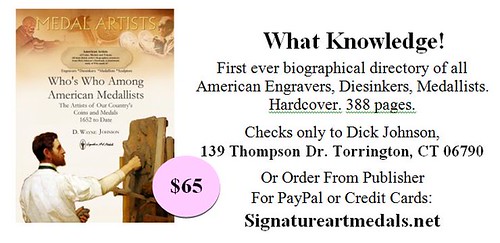
NEWMAN PORTAL DIGITIZES EARLY DEALER PERIODICALS
Newman Numismatic Portal Digitizes 19th and early 20th Century Dealer Periodicals
The growth of the American coin trade in the mid to late 19th century inexorably led to various marketing vehicles, and today the dealer house organs of this era provide an unvarnished view of the American numismatic business in its early stages. The 1870s and 1880s represented the heyday of the dealer periodical, with Ebenezer Mason, Edouard Frossard, and David Proskey holding forth on a periodic basis under various titles.
Mason and Frossard in particular were quite colorful and held back little in the way of personal opinion. Frossard’s July 1884 Numisma, for example, described a Chapman catalog “with margin sufficiently large for corrections.” Proskey was more circumspect, but his Coin Collector’s Journal remains a substantial record of the time, and contained important research such as Robert Coulton Davis’s pattern listing begun serially in 1885.
Collectors have had access to these periodicals through original copies as well as modern reprints, but with today’s scanning technology the full content is now just a few clicks away. The Newman Portal has digitized many of these - a full list is below. The Newman Portal acknowledges Joel Orosz for supplying one of the missing issues in the Elder Monthly series. We also seek copies (unbound preferred) of Elder’s Numismatic Philistine and Elder Magazine (1909-1911), as well as a full run of Mehl’s Numismatic Monthly.

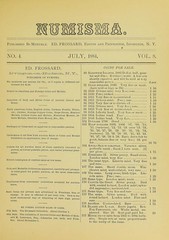
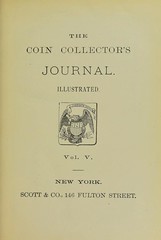
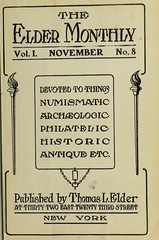
Mason’s Stamp and Coin Collector’s Magazine (and related publications): https://archive.org/details/newmannumismatic?and[]=mason%27s
Frossard’s Numisma: https://archive.org/details/newmannumismatic?&and[]=numisma
Scott’s Coin Collector’s Journal: https://archive.org/details/newmannumismatic?&and[]=scott%20coin%20collector%27s%20journal
Elder Monthly: https://archive.org/details/newmannumismatic?&and[]=Elder%20Monthly
THE BOOK BAZARRE
NEW BOOK: COUNTERFEITING AND TECHNOLOGY
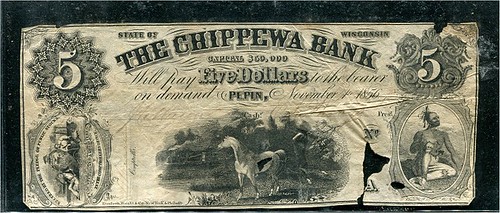
Counterfeit note of the Chippewa Bank, Wisconsin
Since mid-2015 I have had the pleasure of working on a very special project, and now its release is just around the corner. Counterfeiting and Technology by author Bob McCabe is a long-awaited narrative in the world of paper-money accounts. It is an adventurous monument to the history of paper money, and most importantly, to the technology that created it.
Found within are tales spanning from the first paper money ever known to be printed during China’s Tang dynasty to the technology’s journey from East to West. Readers will learn step by step about the art and advancement of line engraving, mechanical engraving, paper-making, ink-making, natural anti-counterfeiting measures, and the modern security printing that goes into making bank notes what they are today.
The chemistries of all the inner-workings of printing are laid out alongside diagrams of printing presses through the ages, from early models to advanced machines that turned out thousands upon thousands of notes during the 19th century. What’s more, these machines are carefully explained so that their functions are easily understood, bringing a whole new life to the paper we use on a daily basis and take for granted without considering its history and evolution. The advancements that finally led to the bank-note–company era, particularly in England and in the United States, are brought forward so that their contributions too can be listed, from small companies to the large “merger” of the American Bank Note Company after 1858. Any student of paper money should have this book to better understand the very foundation of the pieces of history they collect.
But this is not a tale exclusively for the scientifically minded, although those searching for scientific analysis will not be in want. The book is bisected into processes and people, the art of paper making, and those who did the work—including the imaginative and determined rogues who pushed further and further in the art of counterfeiting. In this sense Counterfeiting and Technology is truly an adventure tale, all the more exciting because the stories that are explored within actually happened.
Often the very men who attempted to counterfeit the currency of the time pushed innovators to greater refinements, always seeking designs and securities that fell in line with the highest form of the art. Now, their stories and advancements are captured by author McCabe, who takes readers through early colonial counterfeiting—when counterfeiting could cost a flogging, the loss of an ear (or two), or even death—into the modern day, focusing on the 1800s when the most notorious fraudsters in terms of boldness and technique were at work.
In vivid detail McCabe explores the lives and histories of the men who made ingenious advancements to the chemistry and mechanics of America’s paper money. Anecdotes of daring escapes, chases, undercover investigations, and bold court defenses intermingle with the inception and escapades of the Secret Service and the Bureau of Engraving and Printing. Fraudsters, mostly unknown or unrecognized for their own dishonest cleverness, are finally brought to light by portraits from the National Archives and the U.S. Secret Service Archives.
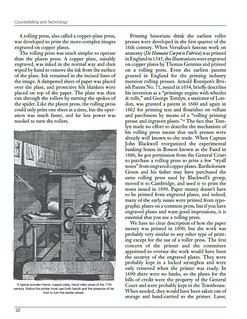
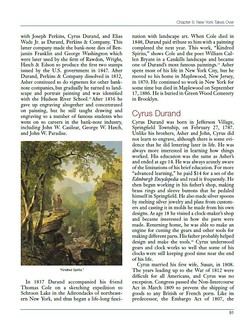
To read the complete article, see:
Bob McCabe Readies New Book on
Bank Note Counterfeiting and Technology
(news.coinupdate.com/bob-mccabe-readies-new-book-on-bank-note-counterfeiting-and-technology/)
NEW BOOK: ROMANIAN COINS (1989 TO 2014)
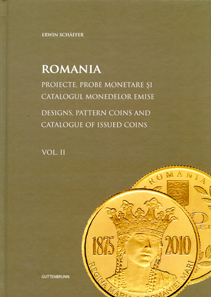 Erwin
Schäffer, Romania - Designs, Pattern Coins and Catalogue of Issued Coins. Vol II. Guttenbrunn 2015. 480 p., color illustrations
throughout. Hardcover. Thread stitching. 21 x 30 cm. ISBN 978-973-0-19455-5. 65 euros.
Erwin
Schäffer, Romania - Designs, Pattern Coins and Catalogue of Issued Coins. Vol II. Guttenbrunn 2015. 480 p., color illustrations
throughout. Hardcover. Thread stitching. 21 x 30 cm. ISBN 978-973-0-19455-5. 65 euros.
Nothing is more revealing about the self-understanding of a country than the images, symbols and persons it choses as self-representation on coins. A coin’s path of development is likewise particularly important in this regard. It says a lot about the society and the image of women when – to mention an example from Swiss numismatics – a Federal Council can take exception to the frivolity of a forelock of Helvetia to the effect that the artist is forced to submit a defrivolitized version of his Helvetia.
This is why Erwin Schäffer’s catalog of Romanian coins, patterns and essays is considerably more than a simple price guide. It presents the material required to assess how much the self-understanding of Romania has changed after the abolition of communism, which people, events and images are deemed supportive of the state nowadays, thereby replacing the most favorite motif of the past, the oil refinery.
The work prepared by Schäffer is impressive. In format and numbering, it is a follow-up of the first volume about Romanian coinage that focused on the coins and essays between 1860 and 1989. This time, the catalog proper is preceded by an introduction into the monetary policy in post-communist Romania, written by Silviu Cerna. A contribution of Johann Jakob gives an outlook of Romania’s current position in the development towards the euro.
The catalog is next, divided into patterns and issued coins. Every piece has a thorough description, with mintage, as far as is known, and further specifics of numismatic importance. As for the pattern and commemorative coins, a price is given for the grade “proof” while the section on circulating coins states prices for up to five different grades. Design drawings, where available, have been incorporated into the pattern section.
Convenient, in terms of chronological overview, is a table that lists all coins with their specific issuing date.
Furthermore, the author has included both the coin sets and some private sets in his catalog.
Information about the national mint, artists and Romanian monetary acts conclude the new standard work of reference on present-day Romanian coinage.
To read the complete article, see:
Romanian Coins (1989 to 2014) (www.coinsweekly.com/en/News/4?&id=3840)
To subscribe to the CoinsWeekly newsletter, see: http://coinsweekly.com/en/Subscribe-to-CoinsWeekly-Newsletter/37

BOOK REVIEW: WHO'S WHO AMONG AMERICAN MEDALLISTS
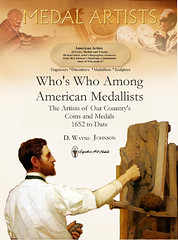 I have collected medals since 1953 and have written extensively in the field. In the interest of full disclosure, I worked for Dick Johnson
and his partner Chris E. Jensen as director of publications and auction cataloger for their partnership of Johnson & Jensen, leaving in 1981.
I have collected medals since 1953 and have written extensively in the field. In the interest of full disclosure, I worked for Dick Johnson
and his partner Chris E. Jensen as director of publications and auction cataloger for their partnership of Johnson & Jensen, leaving in 1981.
Johnson has labored long in the field and introduced many brilliant ideas for which he has seldom received the credit deserved. He was the first editor of the weekly newspaper Coin World. His formulation of methods for coherent and replicable cataloging of medals transformed the auctioning of these collectibles...
Right or wrong, Johnson seldom shrank from controversy. Behind the title page appears a 10-line statement, “Spelling of the word “medallists.” He begins by stating quite correctly “In America the word is spelled with one L. In England the word has two Ls.” He then asserts that he is using the “two L” form throughout, “this continues a tradition established in 1907 when the Medallic Art Company chose this spelling, continued in 1930 with the creation of the Society of Medallists, both with two L.”
Two things: the adjective “medallic” with one L would be improper anywhere in the English-speaking world. The bold assertion that “medallists” with two L’s “continued in 1930 with the creation of the Society of Medallists” is startlingly wrong, as can be seen in my book American Art Medals, 1909-1995, Circle of Friends of the Medallion and Society of Medalists, American Numismatic Society, 2012.
Not all works of all artists can be included in any book, however ambitious, and no book is free of typos and slips of the pen. Most puzzling is the failure to record Geri Jimenez Gould’s creation of the last medal of the Society of Medalists, following Afghan sculptor Amanullah Haiderzad’s uniface, rectangular SOM medal, Kabul Bazaar.
The bibliography at the end of the volume is hard to follow, with titles listed chronologically in order of publication. New, revised or updated editions are generally ignored, such as the update of the great Cornelius C. Vermeule’s Numismatic Art in America, vastly enlarged and published by Whitman in 2007.
Long listings of initials, exhibitions and their catalogs bring up the rear.
Successful use of this book will call for a degree of memorization to enable readers to relocate listings sought since there is no comprehensive alphabetization that covers all contents. Nonetheless, Who’s Who among American Artists should be acquired by any serious medal collector, student or medallic library. Priced at $65 postpaid, the book may be ordered from Signature Art Medals, P.O. Box 920, Groton, MA 01450.
To read the complete article, see:
Reviewing
Johnson's U.S. medal designers book
(www.coinworld.com/news/us-coins/2016/01/david-alexander-reviews-dick-johnson-medallic-artists-book-guest-commentary.html#)
To read the earlier E-Sylum articles, see:
NEW BOOK: WHO’S WHO AMONG AMERICAN MEDALLISTS
(www.coinbooks.org/esylum_v18n37a06.html)
BOOK REVIEW: WHO'S WHO AMONG AMERICAN MEDALLISTS
(www.coinbooks.org/esylum_v18n40a05.html)
BOOK REVIEW: A STUDY IN BANKING (IN SHERLOCK HOLMES)
In the Sherlock Holmes Society of London’s District Messenger #87 (June 29, 1989) was this announcement:
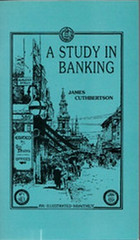 Over the weekend we were also introduced to our member James Cuthbertson’s delightful little book A STUDY IN BANKING: AN INVESTIGATION OF
THE RELATIONSHIP OF MR SHERLOCK HOLMES WITH HIS BANK (“said by experts to be the last word upon the subject”). It costs £3.25 (including postage)
from Mr Cuthbertson at ...
Over the weekend we were also introduced to our member James Cuthbertson’s delightful little book A STUDY IN BANKING: AN INVESTIGATION OF
THE RELATIONSHIP OF MR SHERLOCK HOLMES WITH HIS BANK (“said by experts to be the last word upon the subject”). It costs £3.25 (including postage)
from Mr Cuthbertson at ...
Obviously, this monograph is out of print, but can be found at some online book selling websites for under $20. Spend a few minutes and look for it – it’s well worth the time and dollars.
With only 27 pages, it is a quick read and features an illustration on almost every page, none of which are numismatic related. Cuthbertson breaks the manuscript down into seven sections, making the information very easy to comprehend and not overwhelming the reader. The chapter dealing with Holmes’ banking transactions was especially interesting, in my opinion.
In 1994, Cuthbertson would issue an “addendum” called The Banking Connection 1894-1994 which can be read HERE.
The Fourth Garrideb has donated a copy of this monograph to the libraries of both the American Numismatic Society in New York and the American Numismatic Association in Colorado Springs. The ANA Library does allow its members to borrow books via mail.
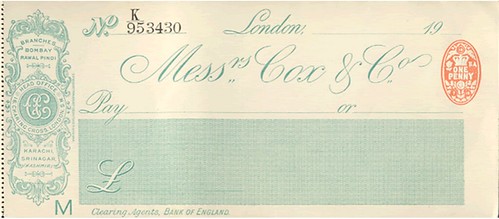
Which of us cannot recall the thrill when we experienced our first reading of Dr. Watson’s electric opening words in Thor Bridge, a thrill we still feel whenever we have occasion to turn to them again –
“Somewhere in the vaults of the bank of Cox & Co., at Charing Cross, there is a travel-worn and battered dispatch-box with my name, John H. Watson, M.D., Late Indian Army, painted upon the lid. It is crammed with papers…”
What endless vistas are conjured up of scandals, crimes and crises, national and international, financial and personal, should it be possible for some of these explosive records to see the light of day – our latter-day political tremors and media revelations would surely seem but trifling in comparison.
Yes, Cox’s was no ordinary bank: it was in a class of its own, and in more ways than one. It began life in the mid-18th century as Agents through whom the Government of the day channelled pay for the Regiments and Services of the Armed Forces, and whilst maintaining this function it evolved into a specialist bank for serving and retired officers of the Forces. Thus it was that when in 1878 Dr. Watson was gazetted into the Army Medical Department and attached to the 5th Northumberland Fusiliers, he would automatically have had an account opened for him at Cox’s, into which his pay and allowances were henceforward credited monthly.
To read the complete articles, see:
Book: A Study In Banking (1989)
(http://fourthgarrideb.com/2016/01/book-a-study-in-banking-1989/)
The Banking Connection: 1894 – 1994
(http://fourthgarrideb.com/2016/01/the-banking-connection-1894-1994/)
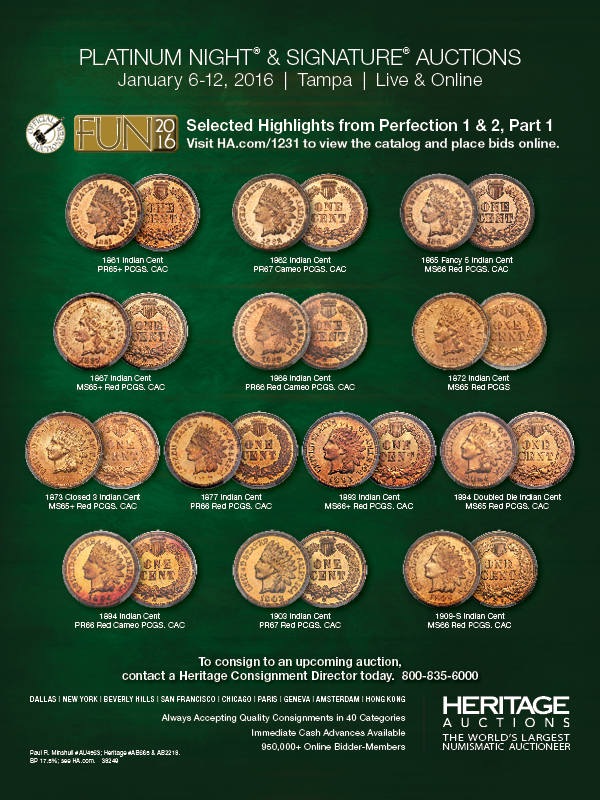
PCGS COINFACTS TO BECOME A FREE SERVICE
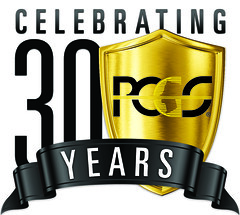 As part of a year-long 30th anniversary celebration, Professional Coin Grading Service (www.PCGS.com) has unveiled an impressive array of
products and services to assist and benefit collectors and dealers. They include ending the annual $149 subscription fee to now make the popular
www.PCGSCoinFacts.com website free to everyone; new developments for the PCGS Restoration Service; and offering “retro-looking” green insert labels
on holders of coins submitted by PCGS Collectors Club members.
As part of a year-long 30th anniversary celebration, Professional Coin Grading Service (www.PCGS.com) has unveiled an impressive array of
products and services to assist and benefit collectors and dealers. They include ending the annual $149 subscription fee to now make the popular
www.PCGSCoinFacts.com website free to everyone; new developments for the PCGS Restoration Service; and offering “retro-looking” green insert labels
on holders of coins submitted by PCGS Collectors Club members.
“PCGS has been serving the numismatic community for 30 years. This is our gift to you for all your support,” said PCGS President Don Willis. He made the announcement at the PCGS Set Registry® luncheon held at the Florida United Numismatists convention in Tampa, Florida on January 8, 2016.
PCGS CoinFacts is the internet’s most extensive resource for information and images about United States coins, from Colonial era to modern commemoratives. The continually updated site now lists over 37,000 different coins, nearly 300,000 images and nearly 3 million auction prices listed.
Effective February 3, 2016, which happens to be the exact 30th anniversary of PCGS’s launch in 1986, the entire website will be available free. PCGS will also launch a new Android mobile application which will join the existing Apple iOS app, allowing anyone to easily access and view PCGS CoinFacts on a mobile device.
For additional information about PCGS products and services, call (800) 447-8848 or email info@pcgs.com
To read the earlier E-Sylum articles, see:
COINFACTS.COM EXPANSION IN WORKS (www.coinbooks.org/esylum_v10n01a03.html)
PCGS LAUNCHES NEW VERSION OF COINFACTS.COM
(www.coinbooks.org/esylum_v12n31a14.html)
DAN HOLMES 1938-2016
 Between 1973 and about 2002, Dan Holmes acquired the most complete collection of United States large cents ever assembled. This was sold in
a series of four auctions by Ira and Larry Goldberg in 2009 to 2011.
Between 1973 and about 2002, Dan Holmes acquired the most complete collection of United States large cents ever assembled. This was sold in
a series of four auctions by Ira and Larry Goldberg in 2009 to 2011.
I met Dan when I attended the EAC convention in Cocoa Beach, Florida, in January of 1979. As I recall, Dan took a dealer table although he did not consider himself a dealer. The dealer fee supported the club and the table gave him a place to sit and talk with his friends. His friends were many.
Dan Holmes, Jr. was born in Cleveland, Ohio, on June 24, 1938. He earned a bachelor’s degree from New York University and went on to earn his MBA there. Later he studied management at the Harvard Business School.
In the 2009 catalog for the sale of his early date cents, Dan told an amusing tale of his summer in 1960. He worked as a guide for the “Three-Corner-Round Pack Outfit” in the southern Sierra Mountains. At the end of the summer he hitchhiked around the west and headed home. He was wearing clothes made from elk hide and had a full beard with curly hair. He carried a recurved bow, a quiver of arrows and had a bowie knife on his belt. He linked up with a group of hobos.
“Thus I began a new career as a hobo. Since I was headed for Cleveland, the advice I received was to wait for a train that would be headed for Kansas City or Chicago. In the meantime we just hung out under the loading dock and watched the trains. Eventually one came along and parked near us. It included a tank car that was leaking. We were nervous that the leak might be dangerous so one of the hobos volunteered to check it out. He came back with a coke bottle full of a dark red liquid and reported that he had struck gold – it was a wine car! We all grabbed our bottles and headed for a fill-up!!!”
In 1962, Dan Holmes, Sr. bought Morrison Products, makers of fans for heating, ventilation, air conditioning and refrigeration (HVAC&R). Dan Holmes, Jr. joined the firm in 1971 as a foreman in the manufacturing plant. He moved up to become President of the firm in 1979.
Dan Holmes, Jr. married Joan Rice on September 1, 1962. Their son Wyandt was born in 1966 and daughter Anne in 1968.
Wyandt worked as a paramedic in Fort Collins, Colorado, and was spokesman for Poudre Valley Hospital EMS. He is married with a daughter. Anne joined the management at Morrison Products and was married in 2010.
When I remember Dan, I think of Sheldon’s color set that he showed off at the EAC conventions. He would tell about meeting Dr. Sheldon in 1976 and acquiring the color set shortly afterward. This was a black leather tray with six columns and eleven rows holding 66 pill boxes. The 60 large cents and six Colonials came in as many colors as there were slots in the tray. There were shades of brown ranging from light tan to charcoal gray. These browns could be mixed with shades of red.
In the other direction were browns mixed with various shades of green. Dan paid $3200 for the set on March 29, 1976. The set remained intact and was sold at auction on September 6, 2009, for $37,950.
The annual EAC auctions included serious offerings of some great copper coins. For comic relief the auctioneer would put up a six-pack of some local beer with the proceeds to benefit the club. Dan was a frequent winner of these beer lots. As winner of the lot, he would present the first bottle to the under bidder. On one occasion when he could not attend the sale, he won the beer lot with a mail bid.
Dan Holmes, Sr. Died in 1984. With success in business, his son had the assets to pursue a serious collection of United States large cents.
By 1986 Dan had completed a collection of the varieties of middle date cents 1816 to 1839. Previous “complete” collections were completed by Frank DeWette Andrews with 205 varieties in 1883 and by Floyd T. Starr with 243 varieties. Three new discoveries brought the Holmes set up to 246 pieces. His collection of middle date cents, 1816-1839, was sold by the Goldbergs on May 30, 2010.
On March 20, 1997, Dan bought the last variety needed to complete a collection of early date large cents 1793-1814 according to the 295 Sheldon numbers. He was the twelfth person to complete such a collection. He also had 52 of the “NC” varieties, missing one unique piece held by the American numismatic Society. This early date collection was sold at auction by the Goldbergs on September 6, 2009.
Dan served as President of Early American Coppers in 2005. He was diagnosed with ALS and resigned his presidency in April 2009. He was 70 years old and understood that continued involvement with the hobby would be limited. He gradually lost control of his muscles but never his mind, which remained sharp.
The last time I saw Dan was at the May 2012 EAC convention in Buffalo, New York. I am sure that travel was a challenge for him in his motorized wheelchair. He came to see his friends and his many friends were glad to see him.
Dan died on January 5, 2016.
Attached is a picture taken in 2007 of EAC President Dan Holmes, in the dark jacket, offering encouragement to a young EAC member in the light jacket. The picture was provided to me by Al Boka.
To read the complete article, see:
In Memoriam – Dan Holmes 1938-2016
(www.coinweek.com/people-in-the-news/in-memoriam/in-memoriam-dan-holmes-1938-2016/)
To read the complete obituary, see:
DANIEL W. HOLMES Jr.
(http://obits.cleveland.com/obituaries/cleveland/obituary.aspx?pid=177216795)
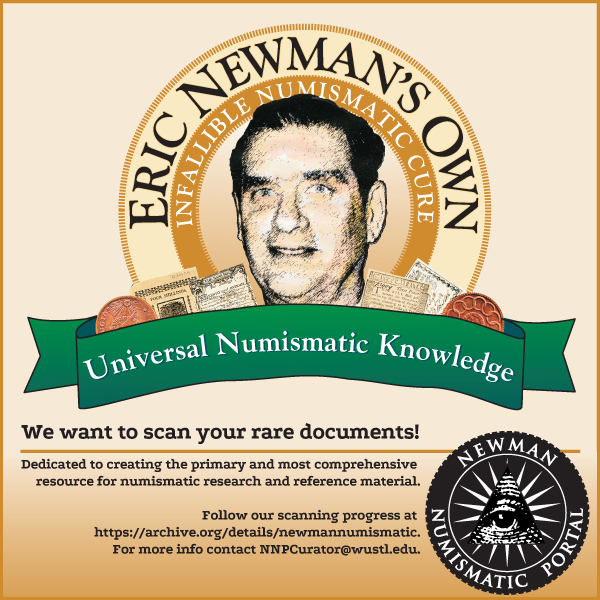
ANA CELEBRATES ITS 125TH ANNIVERSARY
In the 19th century, information about specialized subject matters was hard to obtain, particularly about something as curious as numismatics – the study of coins, paper currency, tokens and medals. Meeting fellow collectors was nearly impossible, especially for those who lived too remote to take advantage of numismatic societies in large cities.
Such was the dilemma of Dr. George Heath of Monroe, Michigan, a coin collector whose efforts at obtaining additional knowledge of the hobby and specimens for his collection were hampered by his location. Supported by his conviction that there was a need for an organization that would reach all collectors, Dr. Heath posed the question, “What is the matter with having an American Numismatic Association?” And so in 1891, Dr. Heath and other numismatists met in Chicago and with 61 charter members founded the American Numismatic Association. “There is nothing like the alliance of kindred pursuits to stimulate growth and interest,” Heath said.
In the last 125 years, the ANA has grown to become the largest nonprofit numismatic organization in the world. The Association provides its 24,000 members access to the best educational programs in the hobby – seminars, lectures, correspondence courses and online learning opportunities – plus the opportunity to engage with like-minded collectors at two annual conventions.
In the early years, conventions provided the opportunity for members to come together, but relatively few took part due to the limitations of travel. The strength of ANA membership depended upon the quality of The Numismatist, a publication first printed and published by Dr. Heath in 1888. Heath did his best to spark interest and provide a wide array of articles, biographical sketches, news items, and the ever-interesting tidbits.
Today, The Numismatist remains the gold standard of hobby publications. In December 2015, the ANA digitized all 127 volumes -- 110,000-plus pages of numismatic history available at the click of a mouse. The online digital editions look exactly like the printed originals, allowing users to experience The Numismatist in its historical context.
National recognition was achieved by the ANA in 1912, when it was granted a Federal Charter, signed by President William H. Taft. An amendment to make the charter permanent was introduced in 1962, and was signed by President John F. Kennedy.
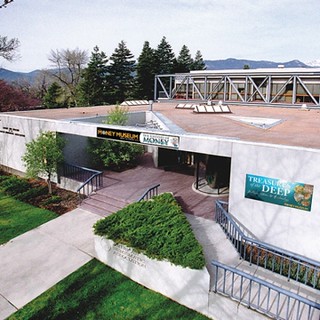 As the Association flourished, a call was made for a national home and headquarters, and a building fund was established in 1961. Sixteen
cities in the central region of the U.S. bid for the location. Ultimately, Colorado Springs, Colorado was selected, and ground-breaking ceremonies
were held in 1966. Thanks to the contributions of nearly 4,000 donors, the ANA headquarters was dedicated and opened on June 10, 1967.
As the Association flourished, a call was made for a national home and headquarters, and a building fund was established in 1961. Sixteen
cities in the central region of the U.S. bid for the location. Ultimately, Colorado Springs, Colorado was selected, and ground-breaking ceremonies
were held in 1966. Thanks to the contributions of nearly 4,000 donors, the ANA headquarters was dedicated and opened on June 10, 1967.
To read the complete article, see:
THE NUMISMATIST CELEBRATES ITS 125TH ANNIVERSARY
(www.coinbooks.org/esylum_v16n05a13.html)
NOTES FROM E-SYLUM READERS: JANUARY 10, 2016
Boxer John L. Sullivan
Dave Ellison writes:
In reference to your Quiz Question in “Handling Coinage in San Francisco in 1885,” as to who is the 'Sullivan' referenced in the article: He was John L. Sullivan, aka the Boston Strong Boy, who is recognized as the first Heavyweight Champion of gloved boxing. He held the title from 1882, to 1892, and won more than 450 fights in his career.
Pablo Hoffman writes:
Too easy !
Everybody knows John L. was the most famous, and I believe the last, champion of the bare-knuckled generation of prize fighters.
Pablo added:
An advantage to being a charter member of the E.A.O.F.B. (Exalted & Aristocratic Old Farts Brigade.)
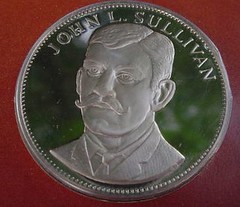 Jeff Starck of Coin World writes:
Jeff Starck of Coin World writes:
I believe Sullivan refers to boxer John L. Sullivan, who DOES have a numismatic connection. The Franklin Mint honored him as part of the Gallery of Great Americans medal series in 1974. Not as neat as the Corbett-Fitzsimmons So-Called Dollar medals, but still neat.
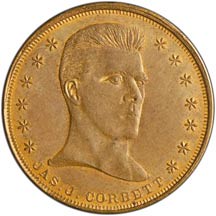
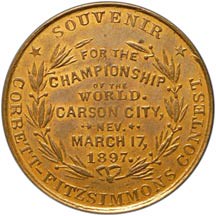
Corbett-Fitzsimmons Boxing Bout Medal
To read the earlier E-Sylum article, see:
HANDLING COINAGE IN SAN FRANCISCO IN 1885
(www.coinbooks.org/esylum_v19n01a19.html)
Chronograms

Last week I asked, "Certain letters in the reverse and obverse exergue inscriptions [of this medal] are larger than their neighbors. Why?"
Chip Howell writes:
Oddly, they're all Roman Date letters, which I presume has something to do with the answer.
Andy Singer writes:
The outsized letters on various coins and medals, mostly European and mostly 17th century and later, are employing a chronogram for dating purposes (i.e. indicating a date for the coin or medal…little to do with social activities). These large letters also correspond to numerals in the Roman system of counting (M = 1000, D = 500, etc.) but they are hidden about in the legends and need to be “collected” and “organized”, then counted, to discover the date. Usually the chronogram is restricted to one side of the coin or medal, but the one you have shown occurs on both: MDCCVVVII, or 1717.
To read the earlier E-Sylum article, see:
NEW YEARS MEDALS (www.coinbooks.org/esylum_v19n01a34.html)
Who Owns A Solomon Islands' Pizza Coin?
Dave Lange writes:
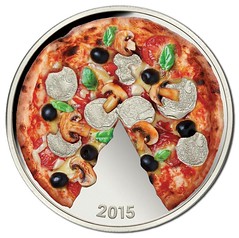 I had a good laugh reading this week's issue when I came across your entry about the Solomon Islands pizza coin. I am among the lucky
recipients of this numismatic delicacy, courtesy of a Christmas gift from my girlfriend. With tongue firmly in cheek, I'd sent her an article
about the coin when it was first announced, adding something to the effect that "This is the only modern coin that would be of interest to
me."
I had a good laugh reading this week's issue when I came across your entry about the Solomon Islands pizza coin. I am among the lucky
recipients of this numismatic delicacy, courtesy of a Christmas gift from my girlfriend. With tongue firmly in cheek, I'd sent her an article
about the coin when it was first announced, adding something to the effect that "This is the only modern coin that would be of interest to
me."
It was a humorous reference to my well documented obsession with pizza, and to my surprise she actually ordered one and presented it to me on Xmas Day. It's actually housed within a simulated pizza box printed in red, white and green. I take this as a reference to Italy, though it may be the national colors of the Solomon Islands, for all I know. I showed the coin to several astonished co-workers the following week, one of whom wanted to test its scratch-and-sniff properties and began to open the capsule. I had to put a stop to that, as it might render the coin "impaired." I presently have no plans to get it certified...
To read the earlier E-Sylum article, see:
THE SOLOMON ISLANDS’ PIZZA COIN (www.coinbooks.org/esylum_v19n01a32.html)

MICKLEY'S DATES OF US COINS AND THEIR DEGREES OF RARITY
David Sundman of Littleton Coin co. writes:
This is from a little display I have on exhibit at our offices in Littleton, New Hampshire. This shows the front page of the monograph.
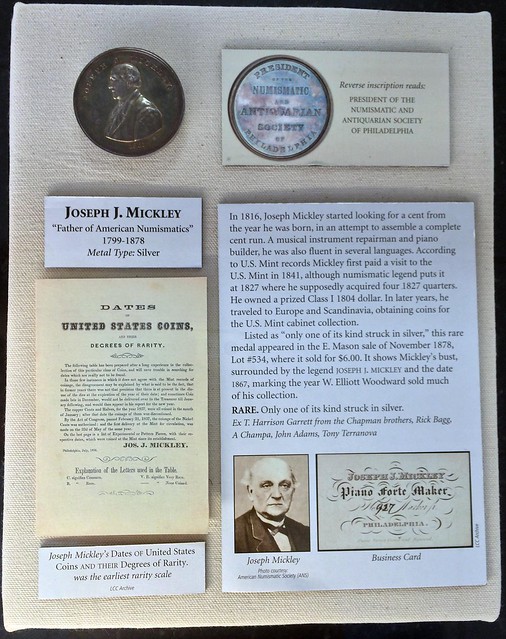
Craig Sholley writes:
Mark Borckardt sent me a scan of his copy of Mickley's "Dates of United States Coins and Their Degrees of Rarity."
It would seem that there is more than one issue of this pamphlet as there are many notations in the numismatic record showing the date of publication as June 1858. However, this copy has Snowden's May 21,1859 offer to trade for Washingtonia, thus establishing that this copy was published after that date.
Likewise, Mickley could not possibly have listed the rarity of 1858 coinage in June 1858.
Saul Teichman writes:
I checked the Charles Davis literature book and it also uses the 1858 date but mentions the 1859 letter on the cover. If there is only one version, then it is an 1859 product.
Do any other E-sylumites know anything about the Mickley pamphlet?
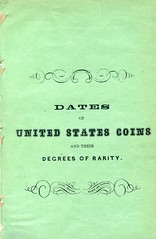
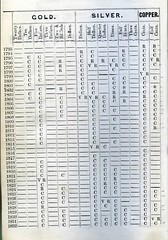
To read the complete article, see:
NOTES FROM E-SYLUM READERS: JANUARY 3, 2016 : Electronic Version of Mickley's
1858 Monograph Sought (www.coinbooks.org/esylum_v19n01a09.html)
MORE THOUGHTS ON RARITY RATINGS
With respect to “Thoughts on Rarity Ratings,” their reliability varies from series to series. Probably no series have been as closely studied as large and half cents. The rarity ratings for those have been determined by counting large, demonstrably random samples of unattributed coins and doing statistical analyses of the results. That works well for coins of which there are at least 25 or so known. For coins rarer than that, if it is a series well-studied like large cents and half cents, the rarity ratings are based on the number of reliably known examples.
In any case, it has nothing at all to do with how many have been auctioned or slabbed in X years. If someone touts a coin as rare because relatively few have been slabbed, run - do not walk - away. There are MANY coins that have not been slabbed, many that have been slabbed multiple times, and many that have been slabbed but not attributed. (Not to mention the fakes that have been slabbed.)
If you’re talking about series that have NOT been so exhaustively studied, which would be most everything else, the fact that 20 or fewer are known does not in any way mean that 20 or fewer actually exist. You are probably safe in betting that many hundreds do not exist, but don’t think your coin is necessarily as rare as the seller is presenting it to be.
Also, ALL ratings have to be taken with a grain of salt. Given the system Brecher used, if you have a good, reliable study that shows that about 75 are known of a variety, is it actually R-5 or R-6? There is no way to know. And if someone tells you a coin is R-5, does that mean there are only about 75 so it’s hard to find, or there are about 200, so it’s much easier to find? Again, there is no way to know.
It’s important not to take ANY rarity rating too seriously.
Morten Eske Mortensen writes:
The topics of rarity-ratings, and the ways that professionals cheat the buyers with false rarity ratings during more than 20 years have been the topic of the publishing house ”Grelbers Forlag” in Copenhagen in more than 200 critical and satirical articles. Some of the 200+ editions have been translated into English language: Re. Støttebetaling for "Månedens Kommentar". (http://grelbersforlag.dk/info/abonnementMaanedensKommentar.htm)
To read the earlier E-Sylum article, see:
THOUGHTS ON RARITY RATINGS (www.coinbooks.org/esylum_v19n01a18.html)
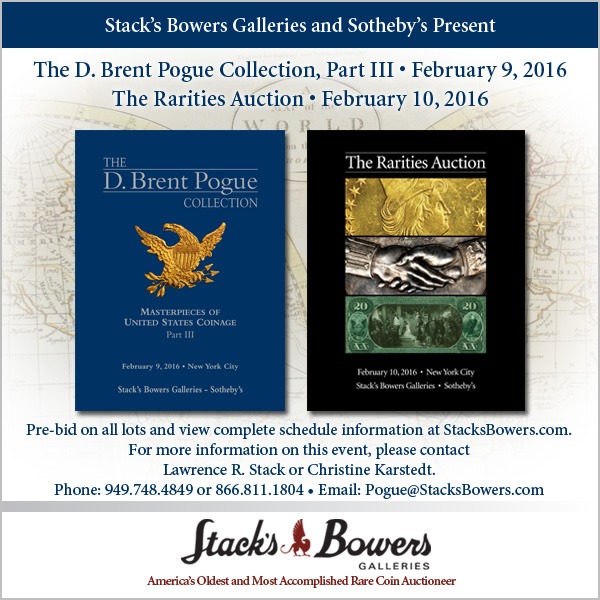
LORENZO HARRIS ABBEY (1822-1881)
Abbey, Lorenzo Harris (1822-1881), was born on January 14, 1822, in Kinderbrook, near Albany, New York.
He and his wife Ann B. Loosee had a daughter Ann Eveline (born 1848). The 1880 Census lists him as a Fish and Tackle Merchant, widowed, living in Brooklyn, New York.
His first known coin auction sale is by Henry H. Leeds & Co., New York, who auctioned his coins on September 8, 1863. A year later W. E. Woodward cataloged coins from four collections Levick, Emery, Ilsley and Abbey in Woodward Sale 10, October 18-22, 1864 sold by G. A. Leavitt.
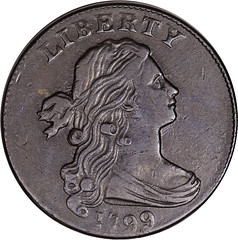
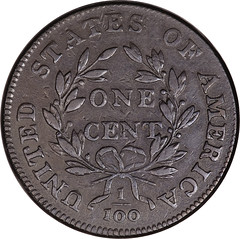
The Famous Abbey Cent
Emmanuel Joseph Attinelli in Numisgraphics discusses this sale and relates the following:
This ‘was a coin sale, succeeding one of furniture, etc. The owner of the coins was the gentleman whose name is perpetuated in the celebrated “Abbey Cent" of 1799, which, notwithstanding so many years have elapsed, since it was brought to the notice of the numismatic public, still maintains its position as “one of the finest known."
Mr. Abbey is a native of this State, having been born in Herkimer Co., on the 14th of January, 1823. He has long been a resident of this city, carrying on an extensive business in needles, fishing-hooks, and tackle. His introduction to numismatology occurred through the following incident :
"Mr. John Martense, a friend of his and a numismatist, having a duplicate uncirculated cent of 1826, presented it to Mr. Abbey, stating that it was worth about $5.00; being somewhat incredulous, he took it to Mr. Sage, who at once offered Mr. Abbey $7.00 for the cent; somewhat astonished by finding fine coins to have such a value, he at once applied himself in diligent search for others, and with some considerable success. The very next day he procured from a grocer’s till the rare “large head Nova Eboraca."
The “ 99 " cent above alluded to, he bought for $25.00 from Mr. Rogers in Fulton St, who had bought it from a countryman for $2.00. Among other pieces he thus brought to the knowledge of numismatists, were the “ Washington Half Dollars " in copper, the 1802 Half Dime, subsequently sold in Mr. Lilliendahl’s sale for $380.00, and other fine or rare pieces.
He is listed in Lain’s Brooklyn Directory as a merchant with a shop in which he was a partner of the firm Abbey & Imbrie located at 48 Maiden Lane, Brooklyn, New York, and his home address as 176 South Elliott Place, New York. The firm was originally founded in 1820 by J. Warrin, the first to exclusively sell Fish and Tackle gear. About 1861 Abbey joined the firm, then renamed as Andrew Clerk & Co., as a clerk and worked his way up to senior partner. In 1875 the firm again changed names this time to Abbey & Imbrie. He and his partner C. F. Imbrie jointly owned a trout preserve on Green’s River, near Sayville, Long Island. Abbey invented a trout fly known as the “Abbey fly”.
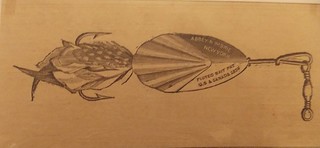
The Abbey Fly
Also in 1875 he issued "Price List of United States Copper Cents for Sale by L. H. Abbey. Box 23, South Orange, New Jersey."
According to the records of the East Orange Historical Society he owned property in East Orange, New Jersey, at 153 Hollywood Avenue, and 250 William Street.
He is famous for the 1799 Large Cent that has come to be known as the Abbey cent.
He died at Jacksonville, Florida on March 17, 1881
To read the complete article, see:
ABBEY,
LORENZO HARRIS
(https://sites.google.com/site/numismaticmallcom/encyclopedic-dictionary-of-numismatic-biographies/abbey-lorenzo-harris)
To read the complete Abbey Cent auction lot description, see: The Famous Abbey Cent
Census-Level 1799 S-189 Large Cent
(http://coins.ha.com/itm/large-cents/1799-1c-normal-date-xf45-pcgs-s-189-b-3-high-r2/a/460-2192.s)
MORE ON MAURITIUS DAVID

New York Herald, Oct 9 1898
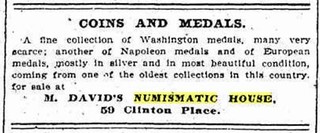
New York Tribune, Oct 23, 1898

New York Herald, February 19, 1899
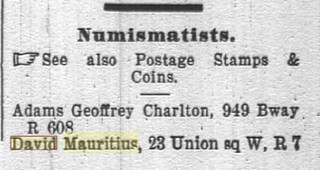
New York City Directory, 1905
To read the earlier E-Sylum article, see:
MAURITIUS DAVID (1860-?) (www.coinbooks.org/esylum_v19n01a12.html)

HOW TO DO NUMISMATIC RESEARCH
What's it take to be a numismatic researcher? Time. Money. Drive. Resolve. In time you will have to add Experience and Knowledge. This was brought to mind this week in Harry Waterson's report to the board of the Central States Numismatic Society which had awarded him a $3.333.33 research grant last year. A condensed version of his 14-page report appeared in the Winter 2015-2016 issue the Society's publication, The Centinel.
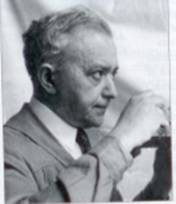 In 2001 Harry found an interest in the medals of the American sculptor Julio Kilenyi (1885-1959) and began building a collection of the
artist's medallic work. From a specialized topic the acquisitions led to a compelling desire to learn more about the artist, his life, his other
artistic creations, in addition to more details about the medals in his collections.
In 2001 Harry found an interest in the medals of the American sculptor Julio Kilenyi (1885-1959) and began building a collection of the
artist's medallic work. From a specialized topic the acquisitions led to a compelling desire to learn more about the artist, his life, his other
artistic creations, in addition to more details about the medals in his collections.
This should be the goal of every specialized collector! Medals are ideal for this numismatic research as far too little is known about this area of numismatics. Researchers and writers can make the greatest contribution to the numismatic field by the pursuit to learn the background and lore of every medal of prominence in their collection. Every medal has a story to tell!
Harry took his burning collector's desire to an elevated numismatic level. He would write a book on Kilenyi through the story of his medallic creations.
To accomplish this he began gathering details of Kilenyi's life and works. From this he identified where he must dig for more information: museums which held Kilenyi's medals, companies which produced them, institutions which had awarded medals Kilenyi created, libraries with possible archives on the artist or his medallic subjects, family records.
With extensive emails and phone calls to curators, librarians, archivists and organizations' media departments, he compiled a list of where he must visit to carry out his research. Hitting the books was also fruitful; he made liberal use of interlibrary loan.
With his CSNS grant in hand he could plan a trip to visit each of these in one massive circuit. His itinerary took shape with stops in 60 locations in 25 different cities. This was to take place over 33 days, driving 4,050 miles. An astonishing accomplishment, this was indeed the “Great Road Trip” as Gerry Tebben called it.
A researcher must go to where the information is located. Librarians, curators and archivists can help. – Their duty is to serve researchers and the public. -- but they cannot do the searching for you. They can guide you to their resources and make suggestions, but researchers must expect to search documents, correspondence, photographs, microfilm, whatever is contained in those holdings.
The “Drive” mentioned above can be interpreted in two ways. Expect to drive a lot, traveling to locations. It also means Determination, stamina for sometimes long hours looking, searching, seeking and the will to do it.
Harry did this, resulting in finding a series of portrait plaques for Baseball Hall of Fame, three new medals he had not known previously, others he had never seen before, new medal varieties, observing medals for two U.S. presidents and lots and lots of facts.
While Harry Waterson's research trip was exceptional for the length of time and the number of locations, it exemplifies the extent a researcher must go to gather information.
Time. Money. Drive. Resolve. It requires all four. As might be expected this must be worked into your life schedule. If you are retired this is ideal. If you are an educator with three months free time in a school schedule, this is ideal. If you can do this during your vacation time, this is ideal.
However, you must consider all four requirements to satisfy that burning desire within you to learn more about those objects in your collection.
I want to encourage all serious collectors to do numismatic research. I will help where I can. I cannot tell who collects a special topic, but I often know who is researching a series. Perhaps you could join forces if you chose the same topic, or you can pick a new subject. With experience like he has I am sure Harry could make useful suggestions as well.
LITTLETON'S MAYNARD SUNDMAN JOINS APS HALL OF FAME
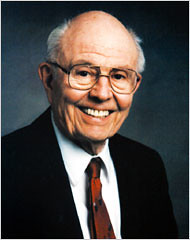 The American Philatelic Society recently announced that Maynard Sundman (1915-2007), founder of Littleton Coin Company and former owner of
Mystic Stamp Company has been named to the American Philatelic Society Hall of Fame class of 2015.
The American Philatelic Society recently announced that Maynard Sundman (1915-2007), founder of Littleton Coin Company and former owner of
Mystic Stamp Company has been named to the American Philatelic Society Hall of Fame class of 2015.
The award, established in 1940, annually honors collectors posthumously for a lifetime of service in philately. Mr. Sundman’s contributions included introducing thousands of new collectors to the hobby with innovative advertisements and mail order offers, as well as expanding the practice of sending stamps and coins through the mail with a range of “on approval” services.
In the January 2016 publication of The American Philatelist, Ken Martin, Executive Director of the APS, wrote that “Maynard’s name – the Mystic name – is synonymous with the most creative outreach venture to new collectors our hobby has ever seen.” He credited Maynard’s efforts as helping to keep the hobby vibrant into the 21st century.
Previous APS Hall of Fame inductees include John Walter Scott, “the Father of American Philately,” George Ward Linn, founder of Linn’s Stamp Weekly, and noted stamp collector Franklin Delano Roosevelt.
To read the complete article, see:
Littleton Coin Founder Maynard Sundman to Join American Philatelic Society Hall of Fame
(http://news.coinupdate.com/37233-2/)

SCOTT DOLSON POLITICAL MEDALS AND TOKENS STOLEN
Larry Dzuibek forwarded a link to a "LIST OF STOLEN ITEMS FROM SCOTT DOLSON'S POLITICAL MEDALS AND TOKENS COLLECTION AND BRYAN MONEY COLLECTION" Click the link below for a 48-page .pdf file including images. The theft occurred around Christmas, 2015. Here are a few images. Please be on the lookout in the numismatic marketplace.
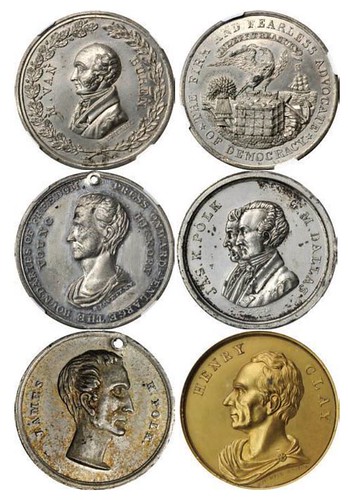
To view the inventory, see:
http://www.apic.us/Portals/6/Images/Dolson_Theft.pdf
OLYMPIC MEDALS IN RR AUCTION SALE
Lot 3001: Athens 1896 Summer Olympics Participation Medal
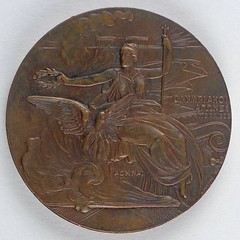

Participation medal issued for the Athens 1896 Summer Olympics. Bronze, 50 mm, 58 gm, by W. Pittner, Austria. The front features a seated Nike holding a laurel wreath over a phoenix emerging from flames, with Acropolis in the background; the reverse bears a star surmounted above five lines of Greek legend set within a laurel wreath.
Lot 3002: Paris 1900 Summer Olympics Silvered Bronze Winner’s Medal
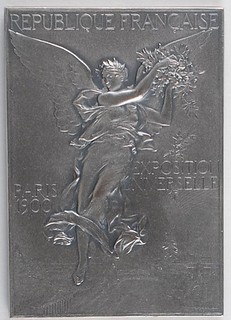
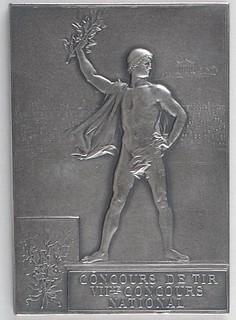
Winner’s medal issued for the Paris 1900 Summer Olympics. Silvered bronze, 42 mm x 60 mm, 57 gm, by Frederic Vernon, Paris. The front, inscribed “Republique Francaise, Exposition Universelle, Paris 1900,” features a winged goddess scattering laurels over the grounds of the Exposition; the reverse identifies the sport as shooting, “Concours de Tir, VIIme Concours National,” and depicts a victorious athlete upon a podium. Stamped “Bronze” on the edge.
Lot 3005: St. Louis 1904 Summer Olympics Participation Medal
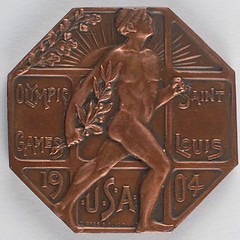
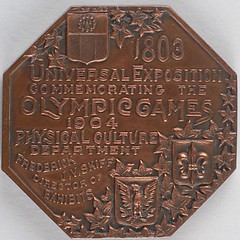
Extremely rare participation medal issued for the St. Louis 1904 Summer Olympics. Copper, 40 mm, 30 gm, by Dieges & Clust, New York. The front, inscribed, “Olympic Games, St. Louis, USA, 1904,” features an idealized nude athlete mid-stride with a laurel branch in his hand; the reverse features the lengthy text, “1803, Universal Exposition Commemorating the Olympic Games, 1904, Physical Culture Department, Frederick J. V. Skiff, Director of Exhibits,” encircled by ivy leaves with the shield emblems of St. Louis, France, and USA. These medals were presented only to athletes and represent the rarest and most valuable of all Olympic participation medals.
Fewer than 700 athletes from twelve different countries competed in the 1904 Olympic Games, the smallest representation of nations in the history of the Olympics. The officials’ badges used the same design as this medal but had a loop on the top for a ribbon, while these athletes’ participation medals have an entirely plain edge.
Because the Olympics were held in conjunction with the Louisiana Purchase Exposition, these are also desired by World’s Fair collectors. Overall, this is a spectacular example of the most sought-after Olympic participation medal.
Lot 3013: Chamonix 1924 Winter Olympics Gold Winner’s Medal
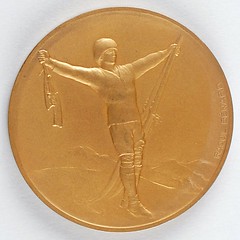
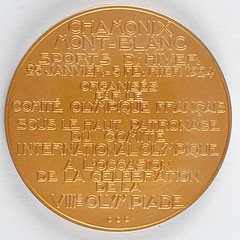
Immensely desirable winner’s medal issued for the Chamonix 1924 Winter Olympics. Gilt silver, 55 mm, 75 gm, by Raoul Benard, Paris. The front features a victorious athlete holding ice skates and skis high in the air with the Alps in the background; the reverse is inscribed at length in French, “Chamonix Mont-Blanc Sports D’Hiver, 25 Janvier–5 Fevrier 1924, Organises par le Comite Olympique Francais sous le haut patronage du Comite International Olympique a l'occasion de la celebration de la VIII Olympiade [Chamonix Mont-Blanc Winter Sports, 25 January–5 February 1924, Organized by the French Olympic Committee under the patronage of the International Olympic Committee on the occasion of the celebration of the VIII Olympiad].” Complete with official red leather presentation box.
The 1924 Chamonix Games were the very first Winter Olympics and sixteen nations were represented. Only 294 athletes participated, making any Chamonix medal very rare—first place winner’s medals are, of course, the most desirable. According to the official medal count, only 33 first place gold winner’s medals were awarded.
Lot 3032: Berlin 1936 Summer Olympics Participation Medal
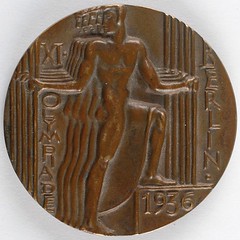

Participation medal issued for the Berlin 1936 Summer Olympics. Brown bronze, 70 mm, 114 gm, by Otto Placzek. The front depicts five athletes, representing the five continents, pulling the ropes of the Olympic bell, with raised text, “XI Olympiade, Berlin, 1936”; the reverse bears the Olympic Bell embossed with the German eagle gripping the Olympic rings within five concentric circles, the name of the designer on the outer edge.
Lot 3042: Melbourne 1956 Summer Olympics Gold Winner’s Medal
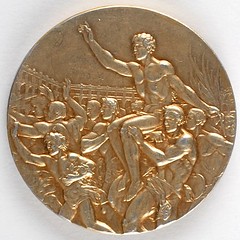
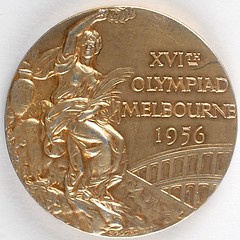
Winner’s medal issued for the Melbourne 1956 Summer Olympics. Gilt silver, 51 mm, 69 gm, by Giuseppe Cassioli. The front, inscribed, “XVIth Olympiad, Melbourne, 1956,” features a ‘Seated Victory’ with the Coliseum in the background; the reverse portrays a winner carried by jubilant athletes. This prize medal design had been adopted for the Amsterdam Games in 1928, with the only alteration for 1956 being a change in wording to reflect the year and location. There were 280 of these gold medals produced, with 273 of them being awarded.
Lot 3049: Tokyo 1964 Summer Olympics Participation Medal


Participation medal issued for the Tokyo 1964 Summer Olympics. Copper, 61 mm, 118 gm, by Taro Okamoto/Kazumitsu Tanaka. The front features three runners and a swimmer placed on an olive branch; the reverse bears the Olympic rings dividing raised Japanese and English text, “XVIII Olympiad, Tokyo 1964.” Complete with its original special wooden box.
Lot 3059: Mexico City 1968 Summer Olympics Participation Medal

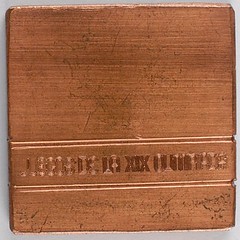
Participation medal issued for the Mexico City 1968 Summer Olympics. Copper, 50 mm x 50 mm, 116 gm, by Lance Wyman. The front depicts various Olympic sport pictograms and the Mexico City Games emblem; the reverse is engraved between two parallel lines, “Juegos de la XIX Olimpiada.”
Lot 3068: Lake Placid 1980 Winter Olympics Participation Medal
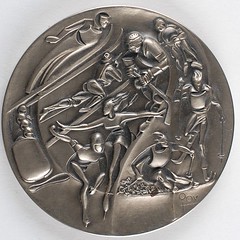
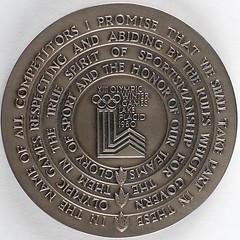
Participation medal issued for the Lake Placid 1980 Winter Olympics. Nickel-silver, 76 mm, 202 gm, by Marcel Jovine/Neil Kennedy. The front depicts modern relief views of the nine winter sports; the reverse bears the Lake Placid Games emblem encircled by the raised words of the Olympic oath in four concentric circles. Complete with its original blue box.
Lot 3078: Los Angeles 1984 Summer Olympics Gold Winner’s Medal
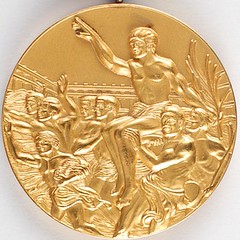
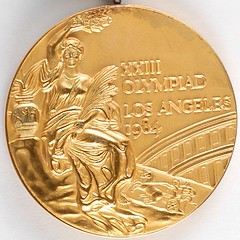
Winner’s medal issued for the Los Angeles 1984 Summer Olympics. Gilt silver, 63.5 mm, 142.5 gm, by Dugald Stermer, Indianapolis. The front, inscribed, “XXIII Olympiad, Los Angeles 1984,” features a ‘Seated Victory’ with the Colosseum in the background; the reverse portrays a victorious athlete being carried by a jubilant crowd. Complete with original magenta, vermillion, and yellow ribbon. Only 478 of these gold medals were produced for the LA Games. A scarce, attractive medal from this memorable USA-hosted Olympiad.
To view the auction lots, see:
Olympic Memorabilia Lots Preview
(www.rrauction.com/preview_gallery.cfm?Category=0)
THE BOOK BAZARRE
ROBERT EIDLITZ AND HIS BOOK ON ARCHITECT MEDALS
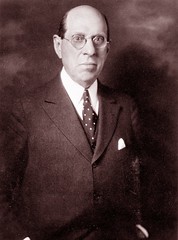 “With architecture and the building industry of this country no name is more intimately associated than the name of Eidlitz.” This
statement is no truer today than when it was written in 1914, but the exaggeration is understandable if you consider the source: a promotional
booklet produced for the 60th anniversary of the founding of the construction firm Marc Eidlitz & Son.
“With architecture and the building industry of this country no name is more intimately associated than the name of Eidlitz.” This
statement is no truer today than when it was written in 1914, but the exaggeration is understandable if you consider the source: a promotional
booklet produced for the 60th anniversary of the founding of the construction firm Marc Eidlitz & Son.
Marc Eidlitz was the father of Robert Eidlitz (1864–1935), a member of the ANS’s governing council and a collector of the medals that would serve as the foundation of his grand and weighty (literally—it weighs 11 pounds) book, Medals and Medallions Relating to Architects (1927).
With two minor exceptions, it was all he ever published, but it was enough to bring recognition in the form of the Society’s Archer Milton Huntington Medal, the committee in charge proclaiming that, “This year the award is made not for a long list of publications, but for a single book of such high quality as to merit this distinction. It is made not only for scholarship, painstaking research, and clarity of arrangement, but for its impressive form, for its dignified printing, and for the excellent arrangement of its plates.”
It’s not exactly clear when Robert Eidlitz began collecting his medals, but it’s no mystery how he arrived at his subject matter: he was born to it. His father Marc, a shopkeeper’s son raised in the Jewish ghetto of Prague, came to New York in 1847 at the age of 21, where he quickly secured an apprenticeship with a builder. By 1854 he had started his own construction firm, finding great success in the expanding city, erecting churches, synagogues, hospitals, and commercial buildings for clients such as Lord & Taylor and Steinway.
Marc Eidlitz & Son was not an architectural firm but rather a construction company that also did general contracting work. Robert, though he had studied architecture at Cornell and the Royal Polytechnic in Berlin, was himself was not really an architect. This was made most explicitly clear during a court case that arose over a payment dispute, where it was stated that, though he was “perhaps the most prominent builder in New York,” he was not officially an architect. In the 1920s, his firm built an addition to the ANS’s Audubon Terrace building. Known as West Hall, it was designed by the architect Henry Brooks Price.
Robert split his time between his home on Park Avenue, which kept him close to his business, and his estate in Westchester County at Dobbs Ferry, where he could relax and turn his attention to gardening and golf. Numismatics was his primary passion, and letters in the ANS Archives attest to the endless hours he spent buying medals and gathering information about them, building his collection of about 5,400 pieces and working on his book, which took 12 years to write.
Though his was the first, and so far only, such work on the narrow topic of medals relating to architects, his idea of grouping numismatic items around a given theme is, of course, not unique. A modern example would be the catalog of numismatic items pertaining to ophthalmology, optics, and vision, Ophthalmologia: Optica et Visio in Nummis, by Jay Galst and Peter van Alfen. ANS curator Howland Wood compared Eidlitz’s book with a then recently published work on naval medals by the Marquis of Milford Haven: “you have him licked in all ways, in all directions.”
The oversized book (12 x 16 inches) was privately printed in an edition of 150, 10 with special morocco covering for presentation, and was sold to the general public for $25 each. It contains descriptions of 1,145 medals, most from his own collection and most with photographs, covering about 550 architects. Desiring to “make the arrangement as pleasing as possible,” he took great care in the layout of the plates, forgoing a strict numeric sequence in favor of esthetic considerations. He distributed many to his friends and associates. J. P. Morgan thanked him for a copy. John D. Rockefeller Jr., upon receipt of the “monumental work,” expressed surprise at Eidlitz’s secret hobby.
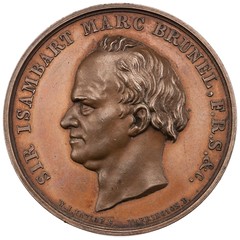
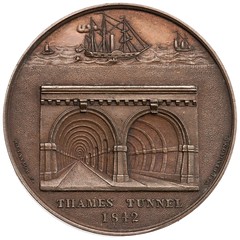
Great Britain. Marc Isambard Brunel, Opening of Thames Tunnel.
Bronze medal by William Joseph Taylor, 1842. Eidlitz 143
The Society mounted a highly successful exhibit of Eidlitz’s collection in 1940, five years after his passing. A private viewing brought 114 people to Audubon Terrace to see it, attendance having been boosted by a “brief but approximately correct notice . . . in the New York Times.”
There was some unanticipated excitement at the event. An official memorandum to the ANS council noted that “the occasion was made memorable by the arrival of the Police Bomb Squad.” This was followed by even more “squads of police,” sent to investigate a phoned-in threat. A great effort was made to calm the guests, including Robert’s wife, Sadie, though it appears there was never any real cause for alarm. ANS president Edward Newell, it was reported, was successful in convincing the police captain to keep the entire matter out of the newspapers.
For more information on the American Numismatic Society, see:
http://numismatics.org/
ON BOOKSHELF MAINTENANCE
The Eidlitz book on Architect Medals is a weighty one, so bibliophiles owning a copy would need a sturdy set of shelves. On the Yahoo Colonial Coins group this week Ray Williams offered these solutions for "groaning book shelves".
If your book shelves are adjustable (removable), when you see them start to bow under the weight of books, remove the shelf and reinsert it upside down. Then replace your books. This way the weight of the books will flatten out the bow.
If the shelves in your book case are fixed and non-removable, and bowing under the weight of the books, here's a suggestion... cut 3/4" plywood panels that are the height of each area between the shelves, and insert them in the center of every shelf opening starting at the bottom. This way, the weight load of all the shelves is supported in the center by the base of the shelves or the floor.
I have one misfit bookcase though, with wide fixed shelves. Bowed shelves. Very bowed shelves. I thought about it and also came up with Ray's solution, but have no lumber around the house and never think to buy any when I'm at Home Depot. So it's a waiting game to see whether deacquisition or total collapse comes first. -Editor
Ray adds:
The 3/4 in plywood inserts take up the space of a book and can be stained or veneered to make them look attractive. Some enterprising numismatist might go to a local library book sale and purchase dummy books of the right size where the spine could be glued to the plywood, or the entire cover could be wrapped around the plywood.
There is another problem I've experienced that can be addressed... Have the adjustable metal clips (or metal pins) that support shelves ever collapsed under the weight? If so, these same plywood panels could be placed at either end of the shelf instead of using the clips or pins. My wife's three glass door china cabinets have experienced both the bowing shelves and the collapsed shelves.
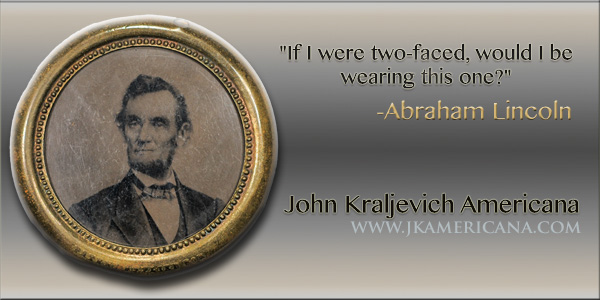
HOW SLAVES EARNED SMALL AMOUNTS OF CASH
Regarding the question of slaves earning money, Matthew Wittmann writes:
My impression is that there was an informal economy that operated in the Caribbean islands/slave societies. Quite simply slavery was not absolute and slaves were able to earn money in a variety of ways, Moreover, they needed some medium to trade among themselves. Much the same thing happened in the United States and the BBC has a good overview of the question.
In short, slaves did need money and low denomination coinage certainly circulated among enslaved peoples.
Generally speaking, slaves enjoyed few material benefits beyond crude lodgings, basic foods and cotton clothing. Still, some plantation slaves were able to earn small amounts of cash by telling fortunes or playing the fiddle at dances. Others sold poultry, meats and liquor or peddled handicrafts. In some cases, slaves could earn money from their master if they performed tasks with particular skill.
The masters, for their part, saw small cash incentives as a way to encourage productive work habits. In the towns, cities and manufacturing areas of the Upper South, slaves were able to earn money thanks to another way to manage labour: the hiring-out system. Contracts differed in terms of food, conditions and treatment, but most slaves hired out to work for others could expect to earn wages for working beyond what was considered a working day. In the tobacco factories of Richmond, Virginia, for example, they would complete their daily quota of work and receive ‘bonus pay’ for anything after that.
Some were also allowed to hire themselves out. Brokering their own deals, they paid their masters a monthly fee and kept anything they earned above the amount. Wages varied across time and place but self-hire slaves could command between $100 a year (for unskilled labour in the early 19th century) to as much as $500 (for skilled work in the Lower South in the late 1850s). Skilled cabinetmakers and joiners could sometimes earn as much as white workers; a select few could even afford to buy themselves out of bondage.
To read the complete article, see:
Slave labour (www.historyextra.com/qa/slave-labour)
To read the earlier E-Sylum article, see:
SMALL CHANGE USED MOSTLY BY ENSLAVED PEOPLES
(www.coinbooks.org/esylum_v19n01a25.html)

WAYNE'S NUMISMATIC DIARY: JANUARY 10, 2016
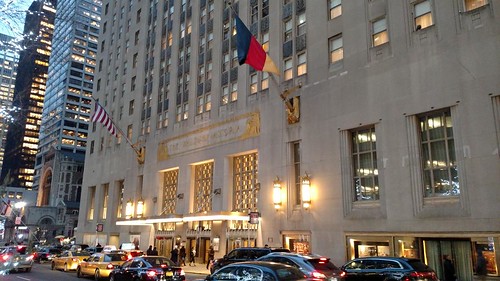
The morning of Thursday, January 7, 2016 found me working on The E-Sylum for a couple hours instead of heading to work as usual. It would be a big day. My wife and I were heading to New York for that evening's ANS Gala and my meetings with ANS personnel for the Newman Numismatic Portal work I'm involved in.
She had a prescheduled appointment late in the morning, but we hit the road immediately afterward, stopping only to buy sandwiches to eat in the car. Our northward journey along I-95 was uneventful, and we arrived at the Waldorf-Astoria hotel around 5pm, just enough time to check in, get dressed and make our way to the lobby where we soon met the evening's Honorees, John and Regina Adams.
The American Numismatic Society 2016 Annual Gala
For background on the event, here is the ANS Press Release.
On Thursday, January 7, 2016 the ANS will honor dedicated benefactors Regina and John W. Adams with the Trustees’ Award during the Annual Gala Dinner at the Waldorf Astoria Hotel in New York City. Mr. Adams, founder of investment bank Adams, Harkness & Hill in Boston and a prolific numismatic researcher, writer, and editor, has been an active member of the Society for decades serving in a variety of leadership capacities.
The Society will also present Kenneth E. Bressett, best known as the longtime editor of A Guide Book of United States Coins (“The Red Book”) and past president of the American Numismatic Association, with the Distinguished Service Award, which is given in recognition of outstanding contributions by an ANS volunteer or member.
The 2015 Burnett Anderson Memorial Award for Excellence in Numismatic Writing, usually presented at the ANA's World Fair of Money, is being presented to Dr. Ursula Kampmann of MünzenWoche (CoinsWeekly).
To read the complete press release, see:
The American Numismatic Society 2016 Annual Gala
(http://numismatics.org/NewsEvents/ANS2016AnnualGala)
I should mention that this was my wife's first-ever visit to New York, so starting off with a Gala at the Waldorf is a great introduction. And speaking of introductions, I spent much of the event introducing Dee to my numismatic friends new and old, including David Sundman, John Lupia, Dan and Connie Hamelberg, Anne Bentley, Bob Leonard, Ken Bressett, Dave Bowers, Ursula Kampmann, Ray Williams and many others.
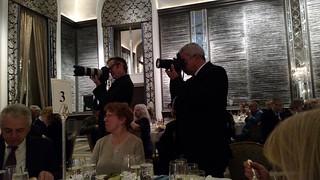 Not to mention, of course, numismatic biblio-folks Joel Orosz, Len Augsburger and his wife Deb, George Kolbe and David and Maria Fanning,
who were seated at an adjoining table. Our own table included Anne Bentley, Neil Musante and his wife CJ. I'll include some of my own photos, but
the event was covered well as can be seen here. We'll look forward to more photos in an upcoming ANS Magazine. I'm also hoping to get
more photos downloaded from my phone for a future issue.
Not to mention, of course, numismatic biblio-folks Joel Orosz, Len Augsburger and his wife Deb, George Kolbe and David and Maria Fanning,
who were seated at an adjoining table. Our own table included Anne Bentley, Neil Musante and his wife CJ. I'll include some of my own photos, but
the event was covered well as can be seen here. We'll look forward to more photos in an upcoming ANS Magazine. I'm also hoping to get
more photos downloaded from my phone for a future issue.
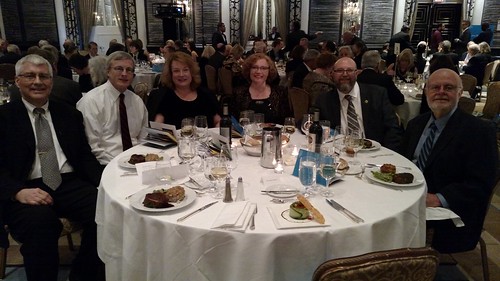
Joel, Len, Deb, Maria, David and George
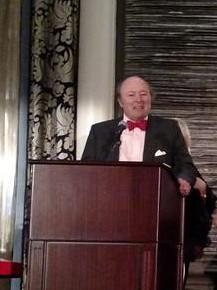 The Gala was a fun affair. Joel Orosz did an outstanding job as emcee. At right is John W. Adams addressing the group. The awards and short
acceptance speeches took place first, with a short fundraising auction, a pun-ny summary of the years events, and a vocalist after dinner. The food
and staff were marvelous, but the highlight was just spending time visiting and talking to so many wonderful people. We hated for it to end, but it
had been a long day and we had an early morning ahead of us.
The Gala was a fun affair. Joel Orosz did an outstanding job as emcee. At right is John W. Adams addressing the group. The awards and short
acceptance speeches took place first, with a short fundraising auction, a pun-ny summary of the years events, and a vocalist after dinner. The food
and staff were marvelous, but the highlight was just spending time visiting and talking to so many wonderful people. We hated for it to end, but it
had been a long day and we had an early morning ahead of us.
Breakfast at Sarabeth's
Dee and I met Joel in the lobby and together we took a cab to Sarabeth's, a breakfast place on Central Park South, where we met Len and
Deb. It was a great way for Dee to get acquainted with everyone and make our plans for the day. Deb and Dee split off for the morning to
shop and sightsee, visiting the Plaza Hotel, Central Park and the Empire State Building. Len Joel and I took a cab downtown to the ANS
headquarters.
The Newman Numismatic Portal at the ANS
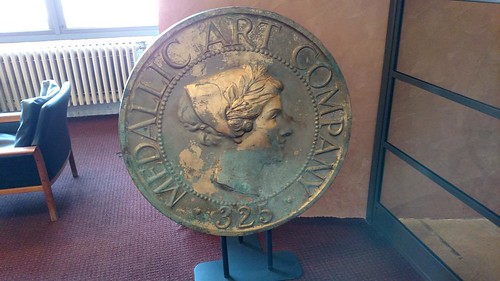
Medallic Art Company plaque in ANS lobby
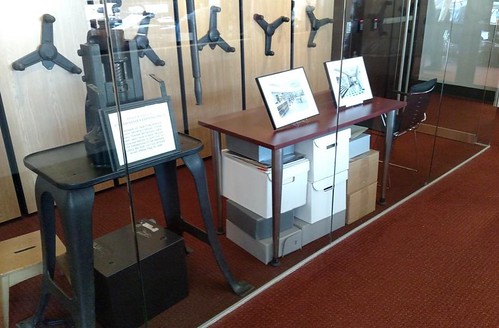
Coin Press display in the ANS Rare Book Room
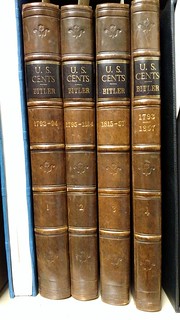 It was my first visit to the new ANS facility on Varick Street. Security was tight and visible, but not onerous. Soon we were inside and
being greeted by ANS Librarian David Hill. Joel was there for research and split off to do his work while Len and I handled Newman Numismatic Portal
business. First, we went to see the scanning equipment setup. David and the scanner operator John Graffeo walked us through the process, which
involves creating a spreadsheet inventory, generating bar-coded labels, and using Internet Archive software to sync catalog information (author,
title, pages etc.) with the online ANS library catalog. It's working pretty well, and books scanned at ANS are often already available on the
Internet within hours.
It was my first visit to the new ANS facility on Varick Street. Security was tight and visible, but not onerous. Soon we were inside and
being greeted by ANS Librarian David Hill. Joel was there for research and split off to do his work while Len and I handled Newman Numismatic Portal
business. First, we went to see the scanning equipment setup. David and the scanner operator John Graffeo walked us through the process, which
involves creating a spreadsheet inventory, generating bar-coded labels, and using Internet Archive software to sync catalog information (author,
title, pages etc.) with the online ANS library catalog. It's working pretty well, and books scanned at ANS are often already available on the
Internet within hours.
ANS volunteer Arnie Tescher was quite helpful to all of us. Len and I prowled the stacks taking mental and photographic notes of items to place in the queue for future digitization. There are many factors to consider, including (primarily) usefulness to researchers, but also the ease of gathering material from the shelves and the amount of effort that would be required to write up the accompanying information. We're still in the low-hanging fruit stage, although eventually we'll go for a back-up-the-truck-and do-it-all approach while funding remains.
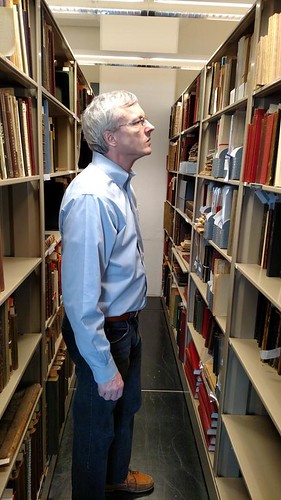
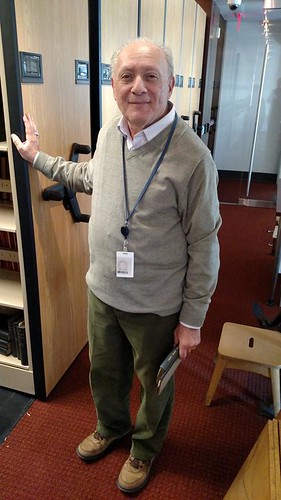
Len Augsburger and Arnie Tescher in the ANS Rare Book Room
The NYINC Convention
Leaving the ANS we three amigos took a cab back uptown where we met the ladies for lunch. They'd had a wonderful time. Deb had to
attend to some business but the rest of us walked back to the hotel afterwards. Dee went back to our room to relax and later I would catch
up with Joel at the Library room where the Kolbe-Fanning sale lots were on view. But first, Len and I went to the NYINC Convention on the
18th floor.
After registering we spoke for a good while with ANS Publications Director Andrew Reinhard. Later I found a few minutes to meet and chat with E-Sylum contributor Pablo Hoffman and advertiser Bob Schwartz of Archives International, as well as Ursula Kampmann of CoinsWeekly.
That was about it for the numismatic portion of the trip. Joel joined Dee and I for a dinner at a nice Italian restaurant several blocks away. Dee and I then had a wonderful time walking around midtown, visiting Rockefeller Center and Times Square. We bought some more souvenirs for our kids. Saturday morning we had time to kill before checkout and went for a long walk in Central Park, toured midtown some more, then sat down exhausted for a nice lunch. The trip home was relaxing and uneventful. It was a productive and enjoyable trip all around. I'm only sorry we didn’t have more time to spend. Dee and I are already planning to come back sometime with our kids.
THE BOOK BAZARRE
A COURSE IN MAMLŪK NUMISMATICS
Following our earlier announcement of the third conference of the School of Mamluk Studies to be held in Chicago, and its accompanying three-day course in numismatics, we would like to once again remind everyone of the course and the procedures to register for it.
Intensive course: Mamlūk Numismatics
A three-day intensive course in Mamlūk numismatics intended for advanced graduate students and other qualified participants will be
offered by Professor Warren Schultz (DePaul University, Chicago, Illinois) and will be held immediately before the third conference of the
School of Mamlūk Studies held at the University of Chicago (June 20–22, 2016).
A reading knowledge of Arabic is required. The course will be demanding and hands-on in its format, but no previous numismatic experience is required.
Since the number of participants will be limited (a maximum of 15), those who desire to take part in the course are requested to submit a CV, a statement of purpose, and a letter of recommendation by someone familiar with their work to [sms2016chicago@gmail.com] by the end of January, 2016. Those who are selected for the course will be notified by the end of February, 2016, at which time information about the method of payment for the course fees will be provided.
The course fee is $300.00, which also includes the registration fee for the subsequent conference (June 23–25) as well the cost of the annual SMS social dinner. The fees must be paid by April 30, 2016. Registration and participation are not confirmed until payment is received. Participants must make their own travel arrangements. The local organizer will provide suggestions for lodging at an affordable price. A certificate of attendance will be awarded.
Marlis J. Saleh, University of Chicago (local organizer)
sms2016chicago@gmail.com
Frédéric Bauden, Université de Liège
Antonella Ghersetti, Ca’ Foscari University, Venice
http://mamluk.uchicago.edu/school-of-mamluk-studies.html
KING HEZEKIAH'S SEAL
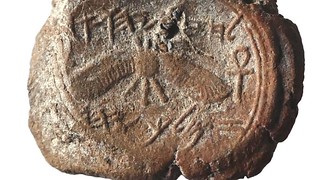 The "Hanukkah miracle" wasn't finding King Hezekiah's seal impression by Temple Mount. It was finding it inside the royal
building in Jerusalem where the seal had actually been used 2,700 years ago, proving its authenticity. The discovery provides further testimony to
the powerful status of the ancient Judahite administration in Jerusalem of the time.
The "Hanukkah miracle" wasn't finding King Hezekiah's seal impression by Temple Mount. It was finding it inside the royal
building in Jerusalem where the seal had actually been used 2,700 years ago, proving its authenticity. The discovery provides further testimony to
the powerful status of the ancient Judahite administration in Jerusalem of the time.
Actually, we had already known the king's seal existed. Impressions from it have been making the rounds of the antiquities market for years. A simulation of the seal is even on display at the Israel Museum, on loan from the Jesselson collection.
The uniqueness of the seal impression announced in December lies in its being a rare solid piece of evidence that Jerusalem housed a major Judahite royal administration. Almost all other seals and bullae from the Judahite era had been illegally dug up and sold by antiquities thieves, rendering them valueless to archaeologists because of their uncertain provenance and questionable authenticity.
This seal impression, called a bulla, was found in a cache together with 33 other seals, figurines and ceramics, inside a collapsed building adjacent to Temple Mount that Jerusalemite archaeologist Eilat Mazar had already deemed to have had an administrative function. About the size of a grape, the impression reads “Belonging to Hezekiah son of Ahaz, king of Judah” and features a symbol of a two-winged sun disk with ankh symbols on either side.
The building in which the bulla was found had been an administrative or royal building that the Babylonians destroyed when they conquered Jerusalem in 586 BCE, Mazar postulates. The archaeologists working there think it was a collapse from an upper floor.
The two-winged sun disk image on the king's seal is also found stamped onto so-called "LMLK" jar handles from Hezekiah's era. (LMLK is merely transliteration of four Hebrew letters on the seals – lamed, mem lamed, kaph, which are shorthand for "belongs to the King".) Some LMLK jar handles features scarab beetles instead of the sun disk.
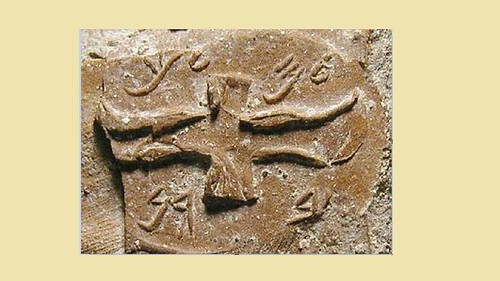
An LMLK stamp on a jar handle
The sun disk itself is a common Near Eastern symbol representing a solar or sky deity, which is what Yahweh essentially was. Its use does not therefore necessarily signify pagan worship by the jar maker or user, or of course by Hezekiah: over centuries of use in the region, these symbols assumed generic meanings.
To read the complete article, see:
Hezekiah Seal Proves Ancient Jerusalem Was a Major Judahite Capital
(www.haaretz.com/jewish/archaeology/1.695308)
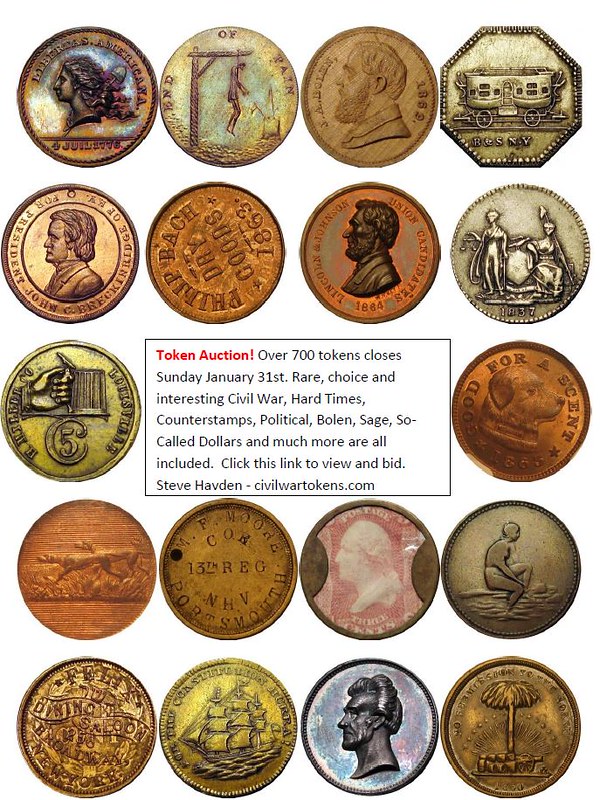
MAN HOLDS RECORD FOR NUMBER OF ACTIVE CREDIT CARDS
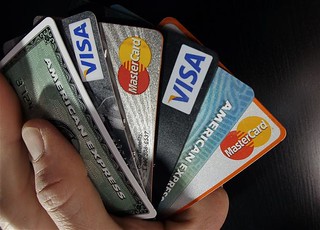 Walter Cavanagh of Santa Clara, Calif., holds the Guinness Book of World Records title of "Mr. Plastic Fantastic," and Money
revisited his story earlier this week. As it recounts, Cavanagh has 1,497 valid credit cards, adding up to $1.7 million in available credit. The wild
stats don't end there: His custom wallet, the world's longest, stretches 250 feet, weighs 38 pounds, and can hold only 800 of his many cards,
not that he carries them around: The Los Angeles Times reported in a 2004 profile that all but one (which he uses and pays off in full in each month,
giving him nearly perfect credit) are kept in a safe-deposit box. Cavanagh's card collection started as "silly bet" with a friend
nearly half a century ago. Whoever collected the most cards by the end of the year would win a dinner. The final score: 143-138 in Cavanagh's
favor.
Walter Cavanagh of Santa Clara, Calif., holds the Guinness Book of World Records title of "Mr. Plastic Fantastic," and Money
revisited his story earlier this week. As it recounts, Cavanagh has 1,497 valid credit cards, adding up to $1.7 million in available credit. The wild
stats don't end there: His custom wallet, the world's longest, stretches 250 feet, weighs 38 pounds, and can hold only 800 of his many cards,
not that he carries them around: The Los Angeles Times reported in a 2004 profile that all but one (which he uses and pays off in full in each month,
giving him nearly perfect credit) are kept in a safe-deposit box. Cavanagh's card collection started as "silly bet" with a friend
nearly half a century ago. Whoever collected the most cards by the end of the year would win a dinner. The final score: 143-138 in Cavanagh's
favor.
With credit cards from gas stations, airlines, and an ice cream store, Cavanagh says he's only been denied credit once, by the now-defunct JJ Newberry Co., which said he had too much credit already. To maintain his title (which he's held since 1971, per ABC News), Cavanagh has to keep amassing cards. If a card isn't valid any more, he doesn't count it as part of his collection. Cavanagh isn't the only collector of plastic. The American Credit Card Collectors Society was formed in 1994 and holds regular conventions. But 29% of Americans actually have no plastic, per an April 2014 Gallup survey cited by MarketWatch. A third of us have one or two, and only 7% have seven or more.
To read the complete article, see:
There's a Man Who Has 1,497 Credit Cards
(www.newser.com/story/218527/theres-a-man-who-has-1497-credit-cards.html)

OLD-DESIGN PAKISTAN BANKNOTES TO BE DEMONETIZED
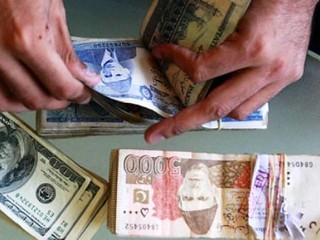 Old-design banknotes will cease to be legal tender with effect from December 1, 2016, the State Bank of Pakistan (SBP) said on
Wednesday.
Old-design banknotes will cease to be legal tender with effect from December 1, 2016, the State Bank of Pakistan (SBP) said on
Wednesday.
“It has now been decided to phase out all remaining old-design banknotes of Rs10, Rs50, Rs100 and Rs1,000. The Rs5 banknote and the old-design Rs500 banknote have already been demonetised,” it said.
The SBP issued a new-design banknote series, which started with the issuance of the Rs20 denomination banknote in 2005 to improve the security, durability and aesthetic quality of banknotes. The process of issuance of a complete series of new-design banknotes comprising eight denominations — Rs5, Rs10, Rs20, Rs50, Rs100, Rs500, Rs1,000 and Rs5,000 — was completed in 2008.
Commercial/microfinance banks will accept the old-design banknotes of Rs10, Rs50, Rs100 and Rs1,000 and exchange the same with the new-design banknotes and coins of all denominations up to November 30.
To read the complete article, see:
Deadline: Old-design banknotes
to be demonetised from December
(http://tribune.com.pk/story/1023143/deadline-old-design-banknotes-to-be-demonetised-from-december/)
INDIAN OFFICIALS SUSPENDED OVER DEFECTIVE BANKNOTES
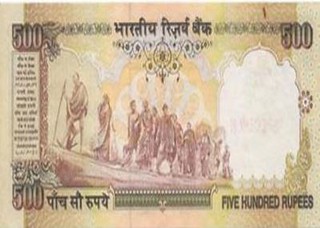 Two senior officials posted at Security Paper Mill (SPM) in Hoshangabad district of Madhya Pradesh were suspended on Friday over production
of millions of defective Rs 500 and Rs 1000 banknotes.
Two senior officials posted at Security Paper Mill (SPM) in Hoshangabad district of Madhya Pradesh were suspended on Friday over production
of millions of defective Rs 500 and Rs 1000 banknotes.
Around 80,000 defective Rs 500 notes and 10,000 defective Rs 1,000 notes produced by the mill has already hit the market, triggering panic among citizens. Security threads are missing in these notes, said an official at Hoshangabad mill. Magnetic security thread with inscriptions 'Bharat' and 'RBI' is the most distinguishing feature in an Indian currency note and prevents counterfeiting.
A shocked RBI asked banks to replace such notes when customers approach them. The notes are genuine, but defective. A five-member team has been constituted by Union finance ministry to launch a high-level inquiry into the matter.
To read the complete article, see:
MP officials suspended over production of defective Rs 500 and Rs 1000 banknotes
(http://timesofindia.indiatimes.com/india/MP-officials-suspended-over-production-of-defective-Rs-500-and-Rs-1000-banknotes/articleshow/50503407.cms)
THE BOOK BAZARRE
DOG CHEWS CHINESE CASH STASH
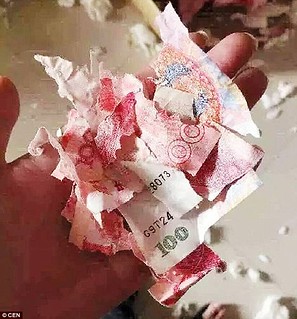 An unlucky man who hid money from his wife in a duvet got his comeuppance when he woke up one day to find his dog had chewed the whole lot
to pieces.
An unlucky man who hid money from his wife in a duvet got his comeuppance when he woke up one day to find his dog had chewed the whole lot
to pieces.
His friend's golden retriever Hali had munched away 3,800 Yuan (£380) while he and his wife were sleeping in Lvshun, northeast China, reports Huanqiu.com, an affiliation of the People’s Daily Online.
They discovered Hali with his innocent eyes staring up at them as he was surround by shredded red and white 100 Yuan (£10) notes.
When his wife asked where the money had come from, he told her it was their own money and that he was just hiding it.
He confessed he did not expect the dog to chew the whole lot up.
Hali is five-months-old, the couple were looking after him while their friend was travelling. He usually chews a teddy bear, so they were shocked to discover he had chewed up the duvet.
On the morning of the incident, the wife woke up to see that the door to the spare bedroom on the ground floor was open. When she looked in, she discovered it was littered with ripped up banknotes.
The blanket had been chewed to pieces and scattered all over the floor, Hali was lying on top of it and staring up at her with his puppy-dog eyes.
To read the complete article, see:
Man
is devastated after the cash he tried to hide from his wife in the duvet is found and SHREDDED into pieces by pet dog
(www.dailymail.co.uk/news/peoplesdaily/article-3386891/Man-devastated-cash-tried-hide-wife-duvet-SHREDDED-pieces-pet-dog.html)
FEATURED WEB PAGE: JOSEPH MICKLEY'S DIARY
This week's Featured Web Page is the American Numismatic Society ARCHER entry for the diary of Philadelphia numismatist Joseph Mickley, courtesy of ANS Librarian David Hill.Biographical Note
 Pioneering numismatist Joseph J. Mickley (1799-1878) was born in Catasauqua, Pennsylvania. He moved Philadelphia in 1818 to study the
repair of pianos and other stringed instruments and by 1822 was operating his own business in the city. He was twice married and the father of six
children. Over the years, Mickley became a regular visitor at the U.S. Mint in Philadelphia, becoming close friends with mint curator William E.
Dubois, who dubbed him the “Father of American Numismatics.”
Pioneering numismatist Joseph J. Mickley (1799-1878) was born in Catasauqua, Pennsylvania. He moved Philadelphia in 1818 to study the
repair of pianos and other stringed instruments and by 1822 was operating his own business in the city. He was twice married and the father of six
children. Over the years, Mickley became a regular visitor at the U.S. Mint in Philadelphia, becoming close friends with mint curator William E.
Dubois, who dubbed him the “Father of American Numismatics.”
Mickley was present at the groundbreaking Lewis Roper coin sale (1851) and attended the meeting that created America’s first organization of coin collectors, the Numismatic and Antiquarian Society of Philadelphia (1857). He served as the group’s first president.
His Dates of United States Coins and their Degrees of Rarity (1858) was among the first coin collector reference books. Mickley, a victim of several coin robberies over the years, suffered a burglary on April 13, 1867, that motivated him to sell much of his collection to William Woodward, who offered it at auction from October 28 to November 2, 1867.
Later that same year, Mickley became an honorary member of the American Numismatic and Archeological Society (later the American Numismatic Society). From 1869 to 1872 he traveled throughout Europe gathering coins from the mints of different countries for Dubois’ U.S. Mint collection. He died in Philadelphia.
Scope and Content Note
There are numerous references to his collecting of books, manuscripts, and coins, and he refers to correspondence with coin collector Charles Wyllys Betts at Yale College (January 6, 1867); seeing one of the collectors of the Cohen family of Baltimore at an auction (March 19, 1867); a visit from Edward Cogan of New York (April 27, 1867); attending Louis Brechemin’s coin auction (June 6, 1867); and correspondence from the London coin dealers Lincoln and Son (e.g., July 24, 1867).
He reports seeing the new Hill engraving machine at the mint (September 17, 1867) and becoming an honorary member of American Numismatic and Archeological Society (December 25 and 27, 1867).
An entry dated December 16, 1866, relates his feelings about what appears to be an offer to buy his entire collection, with Mickley declining, noting the expense of building it and the pleasure it had given him. Three months later, on April 13, 1867, he mentions the burglary that would change his mind, citing his fear of being robbed again in his decision to sell what was left of his collection to [W.E.] Woodward (April 30, 1867). There are several entries mentioning the subsequent sale of his collection (September 27, October 28, and November 2, 1867, and January 2 and 7, 1868).
Mickley makes frequent mention of performing musically in small groups as well as attending musical performances, including one by African American composer and pianist Thomas "Blind Tom" Wiggins (September 18, 1867) and another by the “newly established” Philharmonic Society (January 16, 1869). He also refers to attending lectures at the Franklin Institute and the Academy of Music, and meetings of the Historical Society of Pennsylvania and the Numismatic and Antiquarian Society of Philadelphia.
Also mentioned are an extended trip visiting family and examining coins in Allentown, Harrisburg, Wilkes Barre, Wyoming, and other towns in Pennsylvania (June 1867);
Joel Orosz adds:
Mickley kept diaries for most of his adult life. The one at ANS covers 1866-69, if memory serves. I discovered one at the Historical Society of Pennsylvania that covers part of 1852, and I know of another multi-year diary that is privately owned. But still, many years are missing.
http://numismatics.org/archives/ark:/53695/nnan0003

